PinotFile: 11.8 August 27, 2017
|
On Pinot Trail in Willamette Valley & at International Pinot Noir Celebration Pt II spent ten days on the Pinot Trail in Oregon’s Willamette Valley in late July and there were three words on everyone’s mind: heat, Chardonnay, and (the) French. There were a number of other trends noted as well including, (1) the proliferation of Oregon wineries (now at 702, a 45% increase in the last seven years); (2) the decreasing labor pool (Oregon winegrowers must compete with hazelnuts, blueberries, Christmas trees, and many other crops) creating more interest in mechanical viticulture including harvesting; (3) the increasing popularity of wine tourism in the Willamette Valley has led to a blitz of wine touring companies plying the Hwy 99 corridor and construction of a new 36-room boutique hotel in McMinnville, the Atticus Hotel, scheduled to open in 2018, that will have Portland-based Toro Bravo Inc’s “Third n Tasty” restaurant by restaurateurs John and Renee Gorham; (4) the upsurge in investment in Oregon vineyards and wineries by large corporations such as Jackson Family Wines (see photo below of the old and new - in the foreground an old grain silo in a field adjacent the new Jackson Family Wines soon to open 68,245 square-foot winery on the Evergreen International Aviation’s corporate headquarters' campus near the McMinnville Municipal Airport; (6) and finally, the solar eclipse for which many wineries in the Willamette Valley were perfectly positioned for viewing of this rare event.
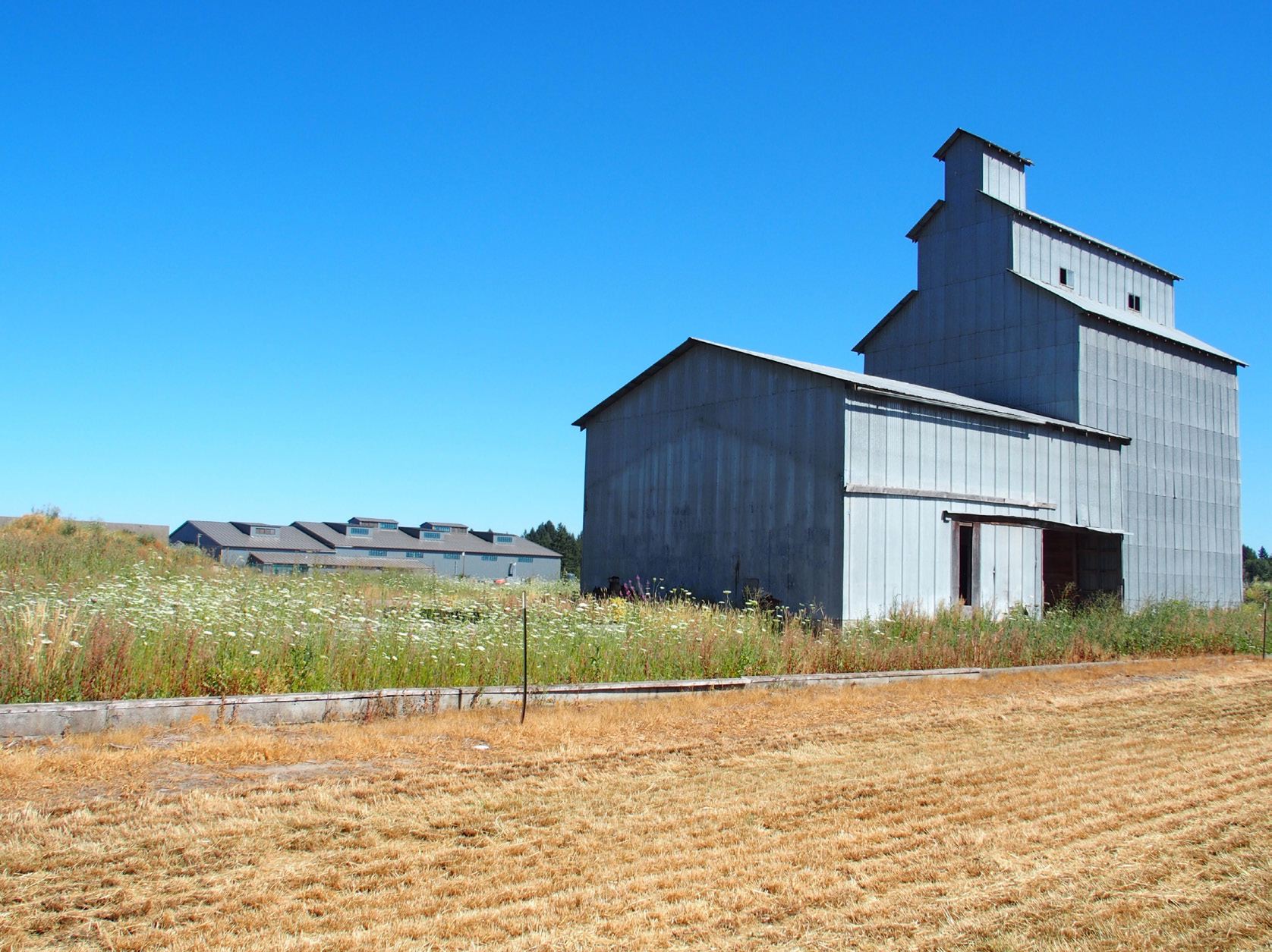 It was unseasonably warm in Oregon, with temperatures soaring to a toasty 88º-92º F every day I was there. Shortly after I left, temperatures reached three digits. Climatologist Greg Jones was quoted in the Capital Press, “The current heat wave is unusual for its magnitude and length, and may turn out to be Oregon’s most extreme since 1981.” On his blog, Jones noted, “Vineyards without irrigation might be able to handle the heat due to available soil moisture, but others will likely see some heat stress, potential sunburn on the fruit, and even leaf desiccation. The heat might actually slow down ripening as the vines often do not get fully back to 100 percent functioning for some time after a heat event like this.” Sun damage is a concern with Pinot Noir since the skins are included in the wine production. The photo below shows two sunburned Pinot Noir clusters from Hawks View Vineyard (courtesy of Anne Amie Vineyards, Carlton, Oregon). So much for “cool climate” viticulture.
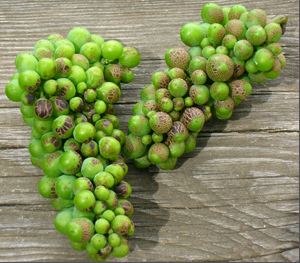 Chardonnay is also “hot,” in Oregon, with considerably more attention being paid to this varietal. Pinot Gris has been Oregon’s signature white grape and Pinot Gris acreage still outnumbers Chardonnay plantings, but Oregon Chardonnay is quickly gaining popularity as vintners gain more traction with this varietal. As Erica Landon of Walter Scott Wines told me, “The many changes taking place right now with Oregon Chardonnay all add up to huge steps forward for those obsessed with making great Chardonnay.” The focus is now on sites appropriate for Chardonnay with many site-specific Chardonnays available, and vineyards are now being purposefully planted to Chardonnay. Examples of Oregon Chardonnay I sampled on this trip were striking. Oregon Chardonnay tends to be lower in alcohol, higher in natural acidity, with less fruitiness, ripeness and oak influence than it’s California counterparts. Oregon is still searching for optimum combinations of site, clone, rootstock and winemaking to realize Oregon’s full potential for Chardonnay but the next ten years will be telling. To read more about Oregon Chardonnay, visit www.princeofpinot.com/article/1821/. Frenchies are now entrenched in the Willamette Valley and their influence is widely felt in the most recent vintages they have had a hand in. It was two centuries ago when French explorers and fur trappers first traveled into Oregon territory and settled. Before the Oregon Trail brought many English-speaking settlers into the Northwest Territory, much of the European population in Oregon spoke French. According to Zeb Larson (“French Twist,” Oregon Quarterly, Winter 2014), “Even the name Oregon may be French. Historian T.C. Elliott theorized that Oregon was a bastardization of the French word ourigan, meaning hurricane or windstorm.” The twentieth century has brought a new wave of French to Oregon, a group of veteran winegrowers and vignerons who see the potential in Oregon for the finest Pinot Noir outside of Burgundy. It seemed only timely that the theme of this year’s 31st Annual International Pinot Noir Celebration (IPNC) was “The French Adventurers: Burgundians Making Pinot Noir in Oregon.” Held at bucolic Linfield College in McMinnville, Oregon, this year’s event was one of the best of many I have attended. Appropriately, Allen Meadows, considered the authority on Burgundy and publisher of Burghound.com, was the Master of Ceremonies. He addressed the 830 attendees on Friday’s opening day, emphasizing the importance of producing wine that speaks of place, wines that can only be from one place, rather than obsessing about scores and competitive advantage. Read on for a full report on this year’s IPNC that is divided into two parts: (1) The Grand Seminar and (2) The Food.
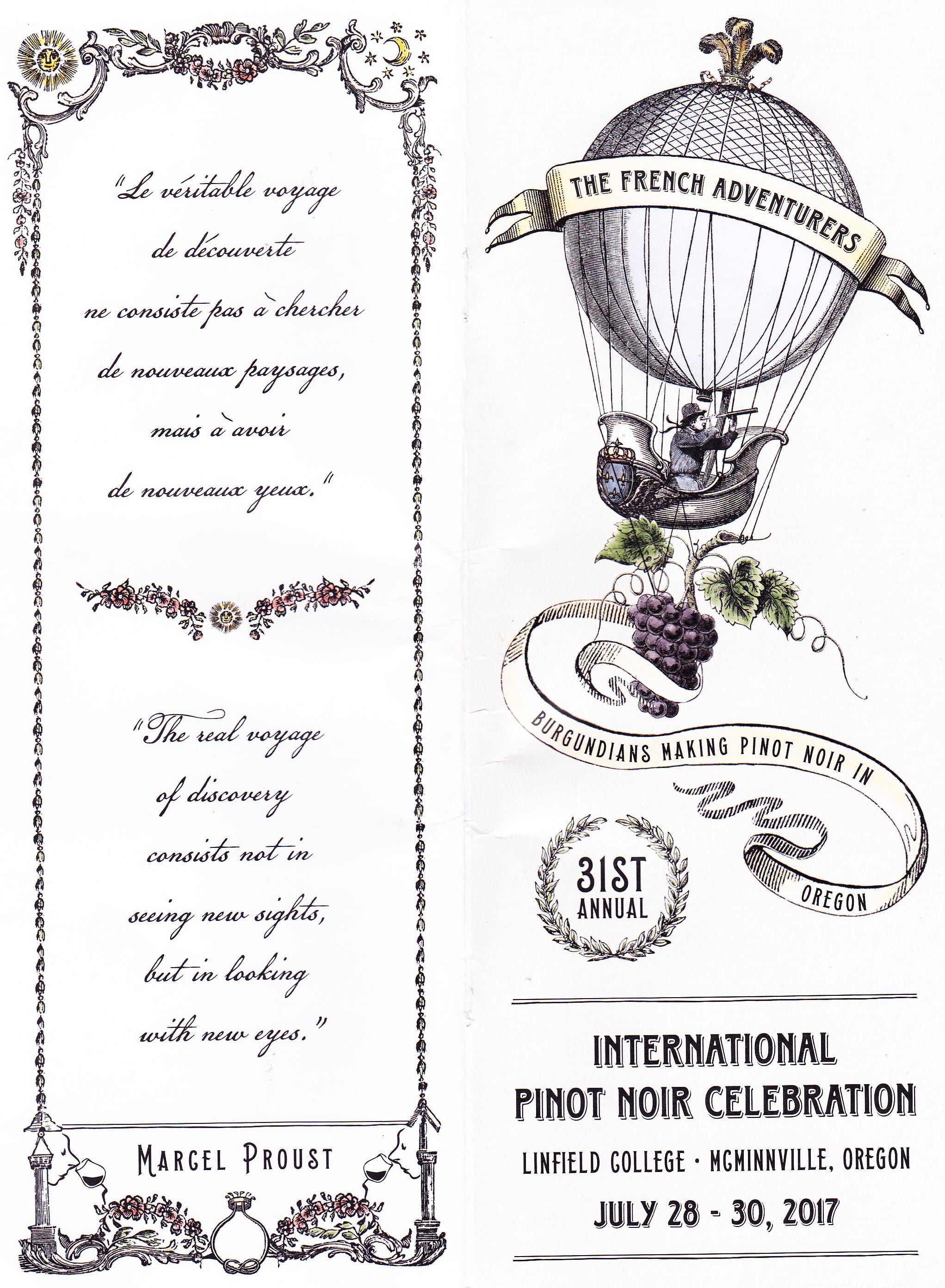
IPNC: The Grand SeminarThe Grand Seminar was titled, “The French Adventurers: Burgundians Making Pinot Noir in Oregon.” The Burgundian entry into the Oregon wine business began in July 1987, when Véronique Boss-Drouhin’s father, Robert Drouhin, the Chairperson of Maison Joseph Drouhin, looked at Véronique while in the Dundee Hills of Oregon, and said, “Let’s try to make wine here. I believe in this place. Véronique says now, “In 30 years, the journey has been as challenging as it has been a fascinating adventure.” It would be twenty years before other French adventurers became committed to Oregon, but the wave of Burgundian enthusiasm for Oregon is now rapidly taking shape. Why Oregon and not California? The French have always had a close relationship with Oregon, beginning with the early Oregon vintners such as David Lett, Charles Coury and David Adelsheim, who traveled to Burgundy to study and established relationships that laid the ground work for future affiliations. Oregonians have always relished Burgundian influence, have been very receptive to the Burgundy vignerons, and the Burgundians have in turn participated with regularity in the Oregon Steamboat Conference and the IPNC.The midpoint of the Willamette Valley lies at 45 degrees north latitude, the same as for Burgundy’s Côte d’Or, so that vintages in Oregon tend to parallel those in Burgundy. In addition, the French often dismiss California’s climate as too hot for Pinot Noir (this was alluded to in the Seminar by the French), finding more value in savoriness, acidity, and texture felt to be lacking in many California fruit driven Pinot Noirs. The French are intrigued with the opportunity in Oregon because they can take their knowledge from crafting Pinot Noir in Burgundy and apply it to a new region. They have more freedom to experiment including blending grapes from different vineyards. There also is the attraction of building something meaningful from scratch. There are very few opportunities in Burgundy to launch and grow new projects. Recent investments in Oregon vineyard land have pushed up prices, but the cost of vineyards is still affordable compared to prime Burgundy plots. Finally, Oregon has a consistently sunny summer (sometimes it rains in Burgundy in July and August), there is less concern about botrytis and essentially no threat of hail, two common challenges in Burgundy. The panelists for the Grand Seminar (left to right), Moderator Eric Asimov of The New York Times, Veronique Boss-Drouhin of Domaine Drouhin Oregon, Dominque Lafon of Lingua Franca, Alexandrine Roy of Phelps Creek Vineyards, Jacques Lardiére of Résonance Vineyard, and Jean-Nicholas Meo of Nicolas-Jay.
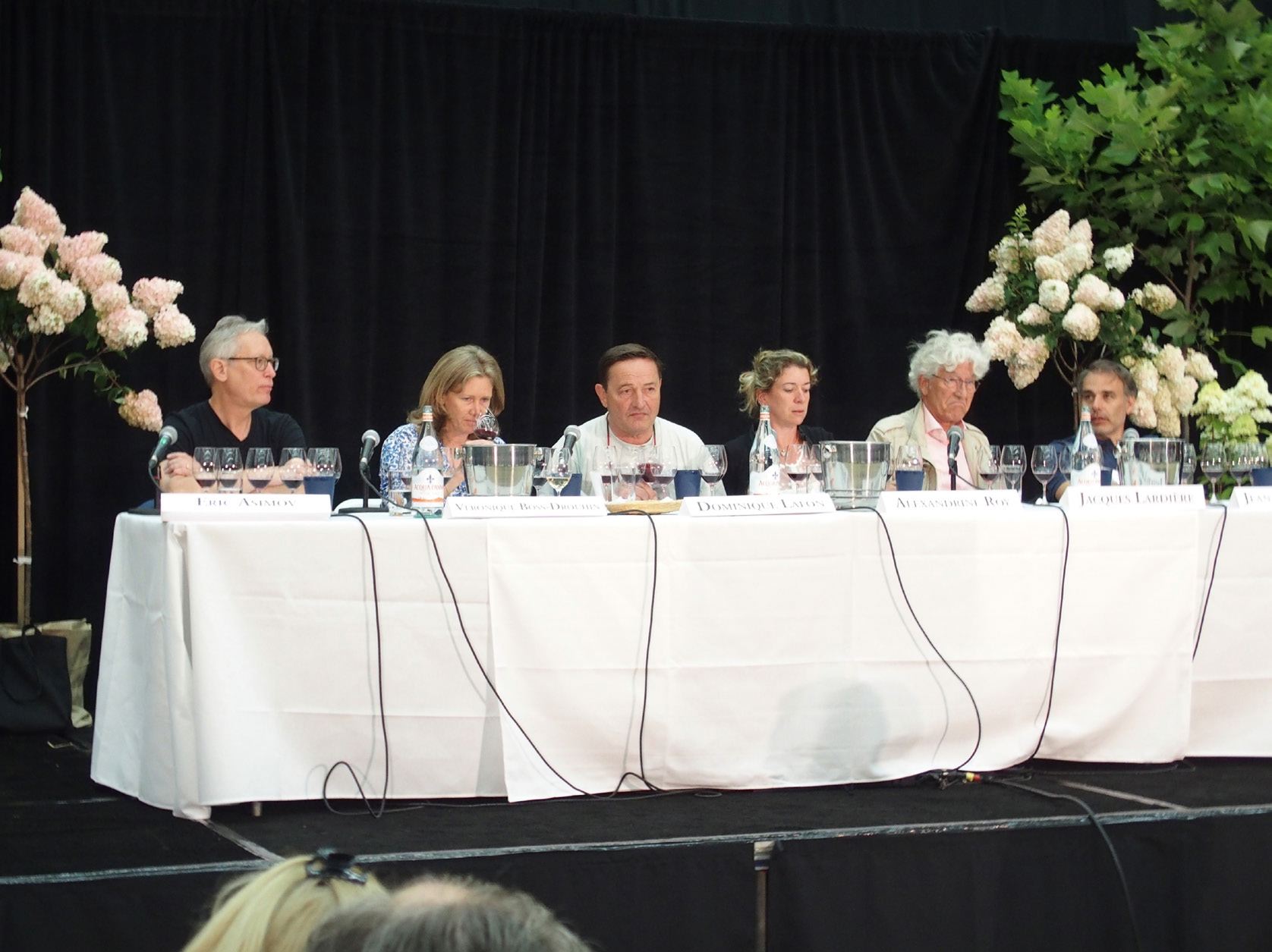 Each panelist offered two wines from their respective wineries as indicated on the table mat below. I must say, all the wines were superb examples of Oregon Pinot Noir, making for one of the most memorable tastings ever at an IPNC Grand Seminar. Following is a brief synopsis of each panelist’s winery.
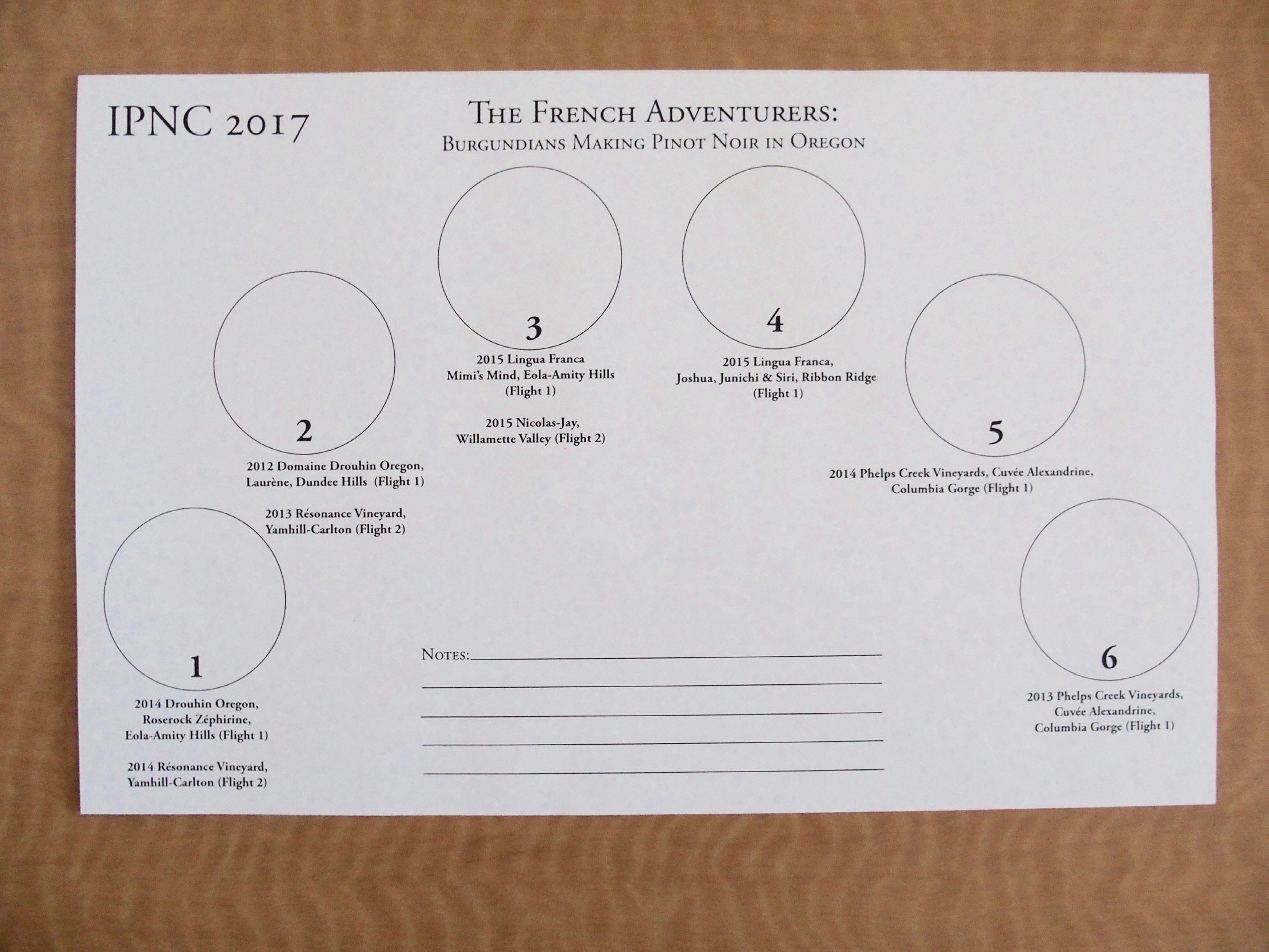
Domaine Drouhin Oregon, Dundee HillsRobert Drouhin, the Chairperson of Maison Joseph Drouhin from 1957 to 2003, visited California in 1961. He met with Robert Mondavi who suggested investing in California, but Robert Drouhin’s interest was Pinot Noir and California had not achieved success with that variety by then. He realized he would have to look elsewhere. In 1979, Robert Drouhin set up a blind tasting of French Burgundies versus their American Pinot Noir counterparts. At this now famous Gault-Mileu tasting held in Paris, a 1959 Domaine Drouhin Chambolle- Musigny came in first, but David Lett’s 1975 The Eyrie Vineyards South Block Reserve took second. This impressed Robert who was struck by the resemblance of the Willamette Valley to the Côte d’Or and the wines produced by Oregon’s pioneering Pinot Noir winemakers. Robert initiated the purchase of 100 acres in the Dundee Hills overlooking the town of Dundee by Maison Joseph Drouhin in 1987, making the Drouhin family the first Burgundian winemakers to invest in Oregon. Robert chose his daughter, Véronique, part of the fourth generation of the Drouhin family and a 1985 graduate of the University of Dijon, to direct the new project in Oregon known as Domaine Drouhin Oregon (DDO). Véronique oversaw the initial planting of high-density vineyards in 1988, and crafted the first three vintages, 1988 to 1990, from purchased grapes. More land was acquired bringing the total to 225 estate acres, 90 of that planted to Pinot Noir and Chardonnay. Véronique-Boss Drouhin is a long distance winemaker, continuing to live in Beaune, but traveling to Oregon frequently to oversee the winemaking at Domaine Drouhin Oregon. Phillipe Drouhin, Véronique’s brother, has managed the DDO vineyards that are among the most densely planted in the United States from the beginning. DDO is one of the few vineyards in the United States to cultivate their own rootstocks and propagate all their own plant material by selection massale. The Pinot Noirs of Domaine Drouhin Oregon have set a benchmark for Oregon, emphasizing balance and elegance over extraction and power. Although they can be quite charming upon release, the wines age magnificently. Véronique told me, “My stylistic goal in Oregon is to produce very elegant wines. It is more of a challenge in Oregon than in Burgundy. In both regions, the goal is the same but the challenges are different. In Oregon it is pretty easy to produce wine with both good color and structure, but to capture the finesse is more tricky. In Burgundy, it is easy to obtain a natural elegance, but sometimes more challenging to get enough color and structure.” In December 2013, the Drouhin family more than doubled their Oregon vineyard holdings with the purchase of the 279-acre (111 acres planted) RoseRock Vineyard in the Eola-Amity Hills AVA. The clever Domaine Drouhin tagline, “French soul, Oregon soil,” could apply to all the wineries participating in this seminar. For more information, visit www.roserockoregon.com and www.domainedrouhinoregon.com. Wines presented at the Grand Seminar: 2014 Drouhin Oregon RoseRock Zéphrine Eola-Amity Hills Pinot Noir $60. Reviewed 11/19/16 in PinotFile - score 91-92. 2012 Domaine Drouhin Oregon Laurène Dundee Hills Pinot Noir $70. Reviewed 11/19/16 in PinotFile - score 94.
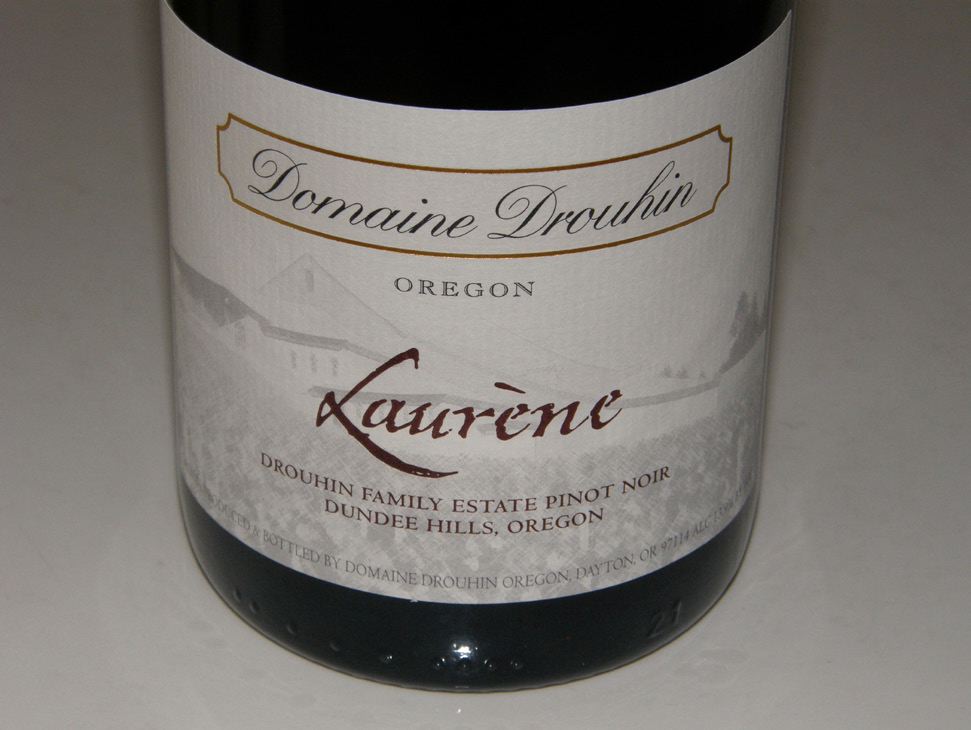 Note: Domaine Drouhin Oregon released this year a Édition Limitée Dundee Hills Chardonnay and Édition Limitée Dundee Hills Pinot Noir, and my reviews are included here.
2015 Domaine Drouhin Oregon Édition Limitée Drouhin Family Estate Dundee Hills Oregon Pinot Noir 14.1% alc., 232 cases, $85. · Moderate garnet color in the glass. A complex nose offers an array of scents including blackberry, blueberry-pomegranate, white pepper, dark rose petal, violet and timber. Rather sappy and luscious in a mid weight plus style with robust flavors of blackberry fruit with accents of spice and toasty oak. Well-structured yet tannins are reigned in enough to allow early drinking. Very pleasing, with a lengthy finish, but with a sense of higher alcohol. Score: 93
2015 Domaine Drouhin Oregon Édition Limitée Drouhin Family Estate Dundee Hills Oregon Chardonnay 13.9% alc., 125 cases, $65. · Light golden yellow color in the glass. Aromas of ocean breeze, wet rock, creme soda, and a hit of butter and toast. A nicely balanced and sophisticated wine, with flavors of green apple, pear, Kaffir lime, and a back note of salinity, energized by lively acidity, finishing with a persistent lemon peel theme. Still solid when tasted the following day from a previously opened bottle predicting age ability. Score: 93
Lingua Franca, SalemMaster Sommelier Larry Stone, a native of the Pacific Northwest, has now achieved his dream of owning his own vineyard and producing Pinot Noir in Oregon. Stone (pictured below at IPNC) was the ninth Master Sommelier in the United States and was the first American to win the prestigious Best International Sommelier in competition in Paris, France. He left the restaurant business in 2006 (he had been a sommelier at Rubicon, Charlie Trotter’s and the Four Seasons) to manage Evening Land Vineyards in Oregon where French vigneron, Dominique Lafon, was the consulting winemaker.
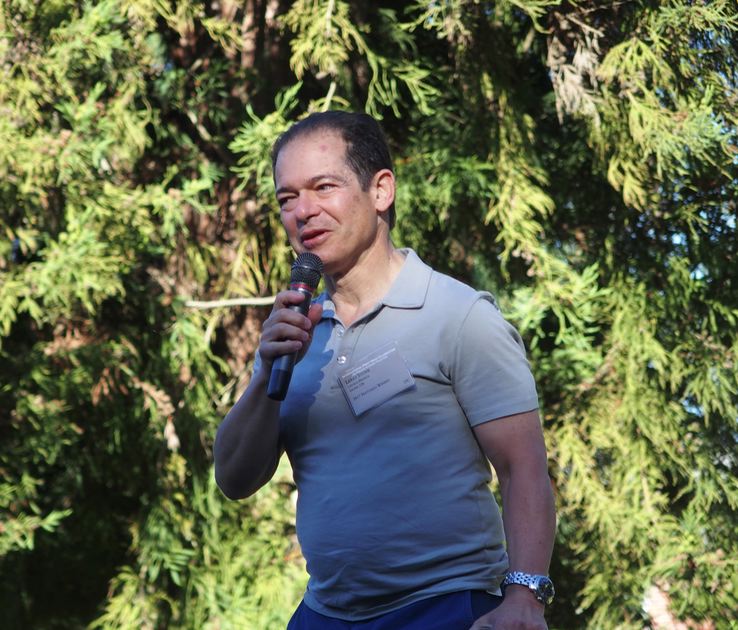 Larry sold his personal wine collection, and with the assistance of friends, family and a major investor, David Honig, who is a successful attorney with experience in the wine business, bought a vineyard site (tentatively named LFV Estate Vineyard) in the Eola-Amity Hills and planted 66 acres to Pinot Noir and lesser amounts of Chardonnay. The vineyard is ideally located near Evening Land’s Seven Springs Vineyard, Argyle Winery’s Lone Star Vineyard, Domaine Drouhin’s RoseRock Vineyard and Domaine Serene’s Jerusalem Hill Vineyard. Beginning in 2017, the estate vineyard will be farmed with the assistance of viticulture specialist Mimi Casteel (Bethel Heights Winery).
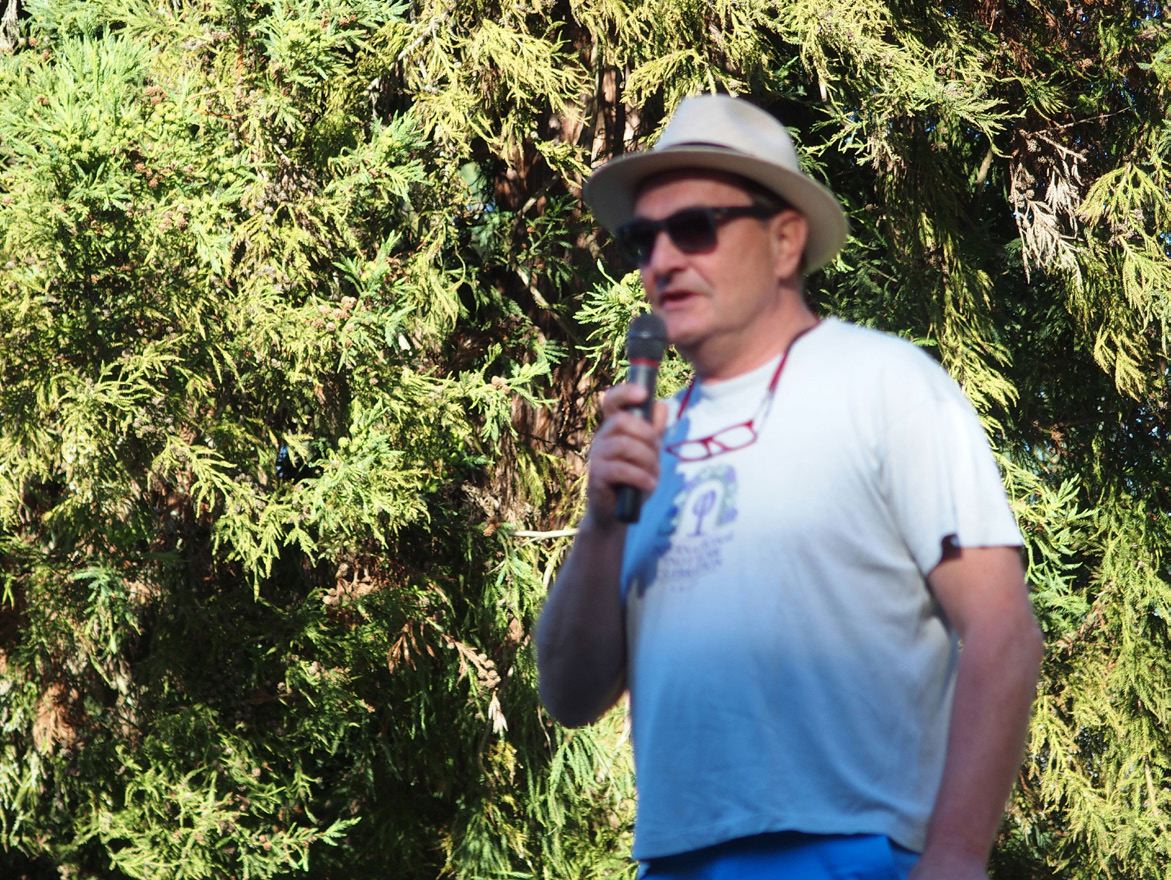 A large, modern winery was constructed and completed in 2016 in collaboration with Burgundy icon and consulting winemaker Dominique Lafon (pictured above at IPNC). Lafon works closely with Stone and winemaker Thomas Savre, a graduate of Dijon University whose experience in Burgundy includes Domaine de la Romanée-Conti and Domaine Dujac, and in Oregon where he was an assistant winemaker at Evening Land. Lafon has been a long time booster of Oregon wines, having attended the first IPNC in 1986. I visited the winery on the estate property before IPNC. It is still undergoing finishing touches but is a magnificent facility with a bank of ten large stainless fermenters along one wall and a similar number of concrete fermenters lining another wall. The inside has very high ceilings and the walls are constructed of 18” thick concrete for insulation.
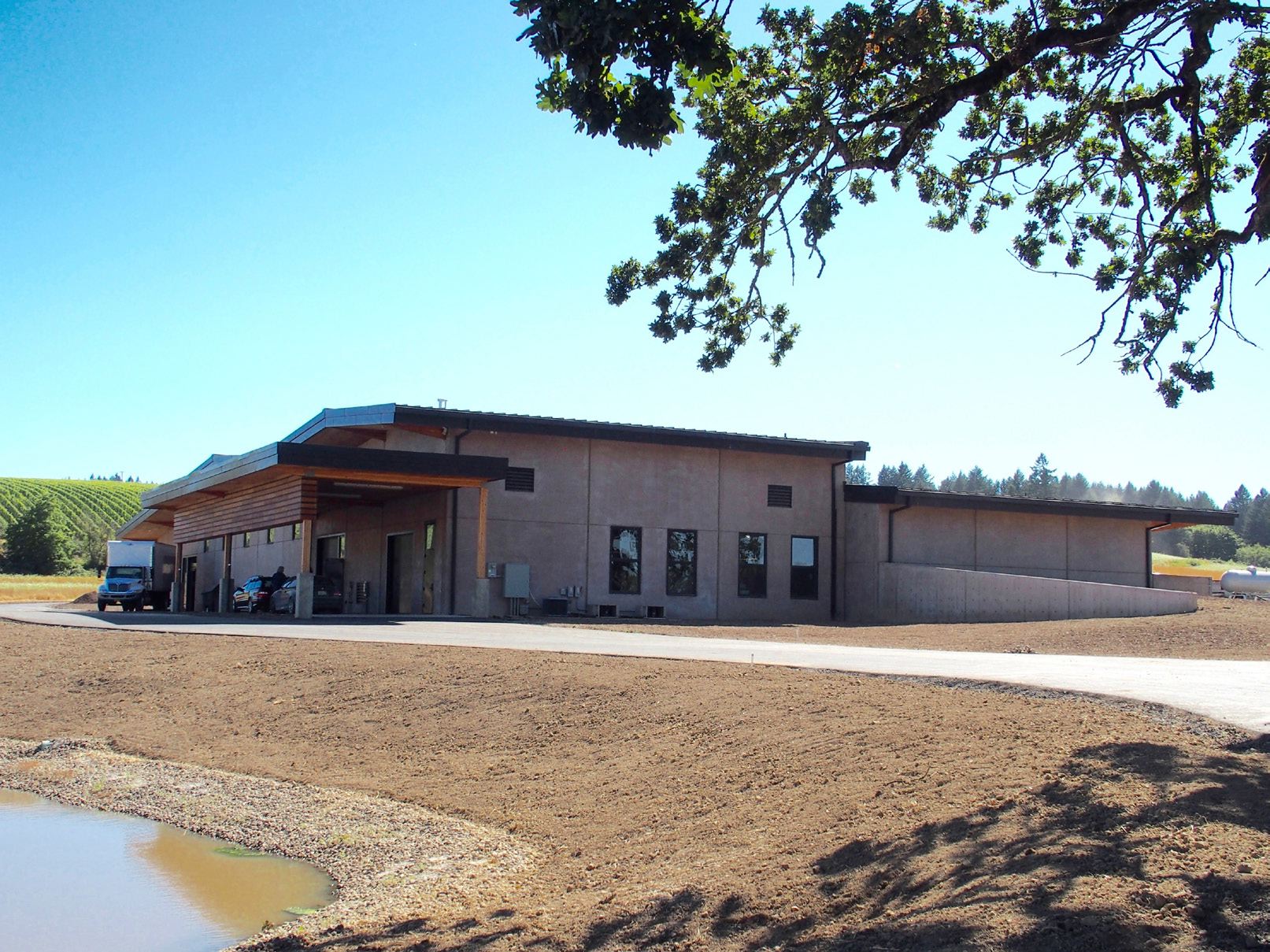 The winery’s first wines were released from the 2015 vintage (produced at Coehlo Winery using purchased grapes). The estate vineyard first harvested fruit came in 2016 and make up the 2016 Lingua Franca Coeur Libere Rosé de Pinot Noir. Lingua Franca has been leasing a 5-acre vineyard, Bunker Hill, in Salem, with Dijon 76 Chardonnay clone planted in 1995 on Nekia soil for the core of the winery’s Chardonnay production. Wines presented at the Grand Seminar: 2015 Lingua Franca Mimi’s Mind Eola-Amity Hills Pinot Noir $90. 2015 Lingua Franca Joshua, Junicki & Siri Ribbon Ridge Pinot Noir $50. Reviewed 6/25/17 in PinotFile - score 93. Wines tasted at the winery briefly: 2016 Lingua Franca Coeur Libere Eola-Amity Hills Rosé de Pinot Noir $22. Lingua Franca Estate Vineyard. Everything you can ask for in a Pinot Noir Rosé with a perfume of fresh red berries and flavors that fall in step. Bright, clean and refreshing. Easily the best Rosé I tasted during this trip to Oregon. 2015 Lingua Franca AVNI Willamette Valley Chardonnay $40. Sourced from 8 vineyards. A more fruit-driven and exuberant style, yet offering vibrant acidity along with a subtle underlay of nutty oak. Reviewed 6/25/17 in the PinotFile - score 93. 2015 Lingua Franca Sisters Eola-Amity Hills Chardonnay $90. Sourced from 4 vineyards but primarily 20- year-old vines at Bunker Hill Vineyard where clone 76 is planted in Nekia soil. A much more serious and high-collared wine that speaks more of minerality and acidity than fruit. 2015 Lingua Franca Joshua Junichi & Siri Ribbon Ridge Pinot Noir$50. Sourced from Redman Vineyard. 50% de-stemmed and 50% whole cluster. A carbonic nose filled with spice and burnt tobacco notes and a charming core of fresh raspberry and cherry fruit flavors. Seductive. Reviewed 6/25/17 in the PinotFile - score 93. 2015 Lingua Franca AVNI Eola-Amity Hills Pinot Noir $40. A regional blend sourced from neighboring vineyards. A savory wine with the essence of black cherry embellished with notes of oak and herbs framed by firm tannins. 2015 Lingua Franca Tongue ‘N Cheek Eola-Amity Hills Pinot Noir $60. Sourced from Elton Vineyard with vines planted in the early 1970s. Pommard and 115 clones. The wine has a good structural backbone and very appealing black cherry and black raspberry fruit flavors. Streamlined and easy to like with a thoroughly satisfying finish of uncommon length. Reviewed 6/25/17 in the PinotFile - score 94. 2015 Lingua Franca Ryan’s Plow Willamette Valley Pinot Noir. $60. Sourced from Seven Springs Vineyard (Calera clone) and Black Walnut Vineyard (Pommard and 667 clones). Modest whole cluster. A combination of vibrant cherry and berry fruit and spice aromas and flavors that have remarkable mid palate presence. An appealing earthiness is boundless. Finishes strong with uplifting cherry notes. Reviewed 6/25/17 in the PinotFile - score 94.
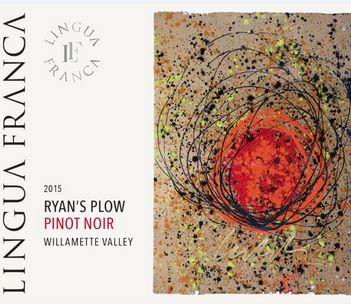 2015 Lingua Franca Mimi’s Mind Eola-Amity Hills Pinot Noir $90. Named after Mimi Casteel, the winery’s viticultural advisor. Sourced from Mimi’s vineyard that has soil similar to Lingua Franca estate vineyard. 20% whole cluster. The most primary wine in the lineup featuring gobs of black fruits, a velvety mouthfeel, and muscular skin and stem tannins. Drink now with a steak but better to wait. Eventually this will be a “Wow!” wine that can be the centerpiece of a dinner. This project is one of the most impressive new launches on the Oregon Pinot Noir scene. I reviewed several of the 2015 Pinot Noir and Chardonnay releases in a recent issue of the PinotFile. I also visited the winery prior to IPNC where I was hosted by Larry Stone. He is a very warm and humble individual who patiently poured all the Lingua Franca wines currently offered accompanied by considerable insight and commentary. These highly desirable wines are sold on the website at www.linguafranca.wine, with magnums available at the winery.
Phelps Creek Vineyards, Columbia GorgePhelps Creek Vineyards was founded in 1990 in Hood River, Oregon, by Robert Morus, a Delta Airlines captain. The property is a 77-acre, steeply slopped site with stunning views of Mount Hood. The 34-acre vineyard is planted to own-rooted and grafted Pinot Noir, Chardonnay and Pinot Gris. The initial Pinot Noir plantings (Pommard, 777 and 115 clones) date to 1990 and Chardonnay plantings (75 and 76) to 1992. Alexandrine Roy, of Domaine Marc Roy in Gevrey-Chambertain, (pictured below at IPNC) a fourth-generation winemaker, joined the winemaking team as a contributor in 2007. By 2012, she had become the Director of Winemaking in charge of all wine production. Alexandrine typically visits the winery 3-4 times each year, focusing on applying traditional French winemaking techniques to Phelps Creek’s limited production wines. Her signature style is offered through Cuvée Alexandrine, Phelps Creek’s flagship Pinot Noir, “Beehive” Pinot Noir, Fleur de Roy, a Rosé of Pinot Noir, and “Corduroy,” a Pinot Noir Blanc. Alexandrine is one of the few Burgundians to faithfully attend IPNC every year.
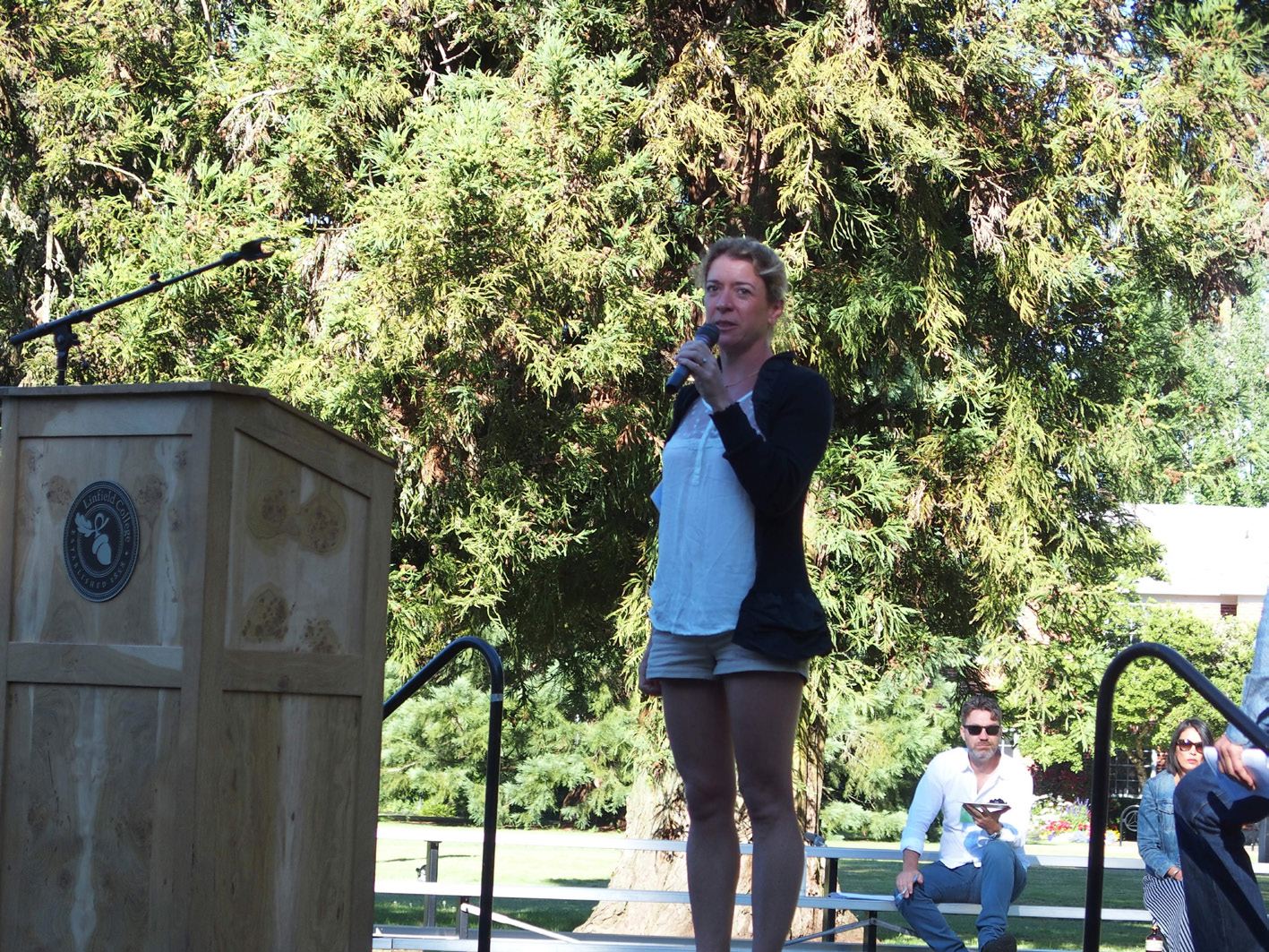 The Phelps Creek tasting room in Hood River is open daily. The wines are also sold through the website at www.phelpscreekvineyards.com. See the PinotFile for many reviews of Phelps Creek Vineyards wines. Wines presented at the Grand Seminar: 2013 Phelps Creek Vineyards Cuvée Alexandrine Columbia Gorge Pinot Noir $54. Reviewed in the PinotFile 5/25/15 - score 92-93. 2014 Phelps Creek Vineyards Cuvée Alexandrine Columbia Gorge Pinot Noir $54. Reviewed in the PinotFile 2/1/17 - score 96.
Résonance Vineyard, NewbergJacques Lardière (pictured below at IPNC) was the winemaker at Maison Louis Jadot for 42 vintages, handing over the reigns in 2013 to Thibault Gagey, the son of Pierre-Henry Gagey, the president of Louis Jadot. Jadot had decided to invest outside Burgundy to expand its business and chose Oregon after several visits because of the availability of the appealing Résonance Vineyard and the fact that the United States is a significant market for Jadot wines. After retiring, Lardière moved to the Willamette Valley to craft the Résonance wines, named because the vineyard marked the departure point of a new adventure. There has been a tremendous amount of ballyhoo regarding Résonance. Résonance Vineyard was owned by Kevin Chambers, who sold grapes to Sineann and Big Table Farm and made wine under the Resonance label. It is an own-rooted 22-acre vineyard on 32 acres in the Yamhill-Carlton AVA planted in 1981 primarily to Pinot Noir. Some existing Gewürztraminer was grafted over to Pinot Noir by Louis Jadot, and Chardonnay may be produced from the site in the future. 2013 was the first vintage of Résonance Pinot Noir vinified under Jadot ownership. Résonance is Maison Louis Jadot’s first venture outside the United States since their inception in 1859, and the first vineyard purchased outside France since 1826.
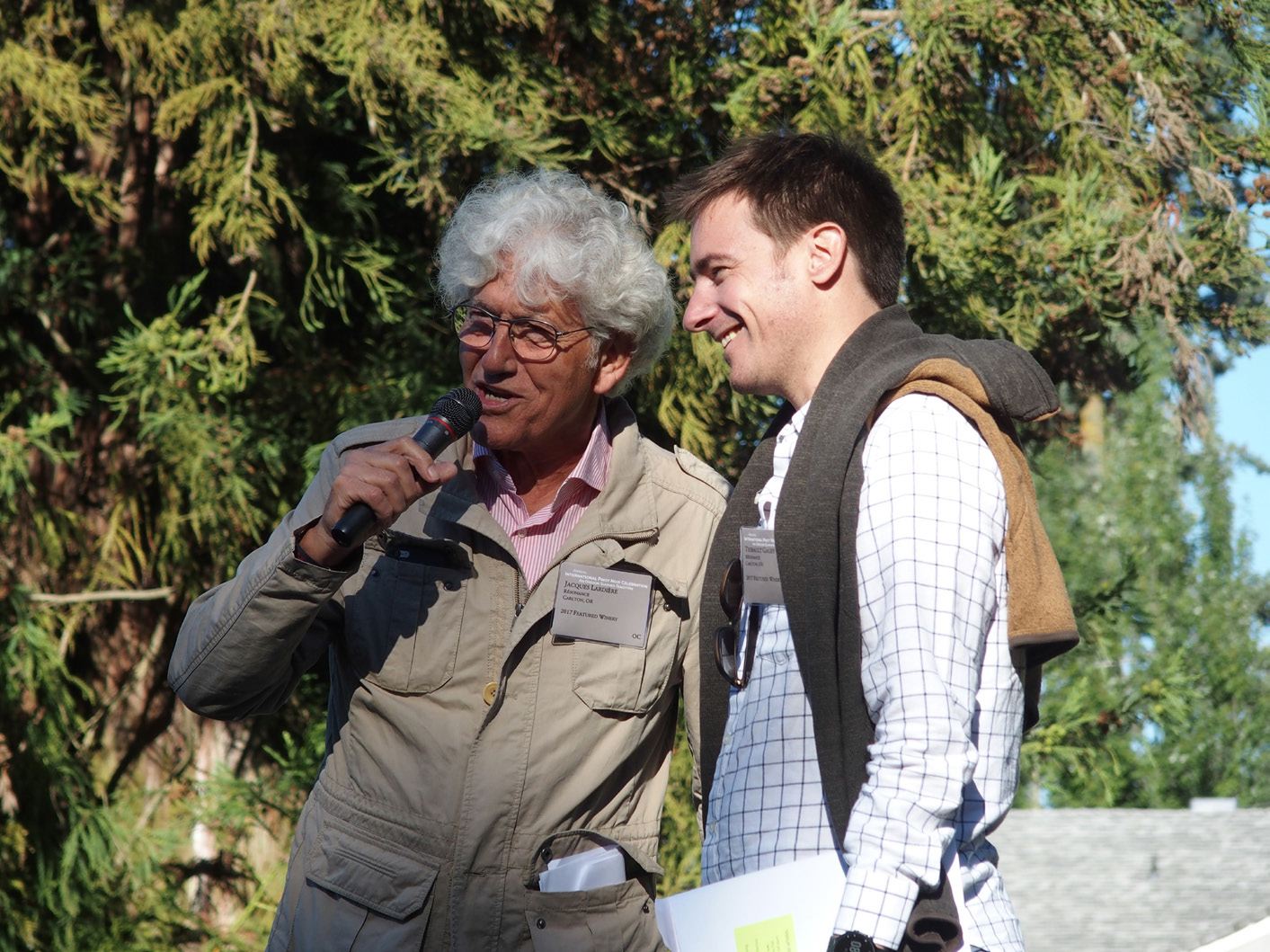 The Résonance Vineyard is protected from inclement weather and wind on all sides and is a warm, dry site as a result. The vines are own-rooted and dry-farmed. Pinot Noir plantings include 10 acres of Pommard (1981 and 2006), 7 acres of Wädenswil (1987 and 2006), 2 acres of 777 (1995). Louis Jadot also bought a 17 acre site in the Dundee Hills AVA in 2014 with 7 acres planted to Pinot Noir. Wine from this site will be called Découverte with the first release from the 2014 vintage. The wines are made by young Burgundian winemakers under the supervision of Lardrière who is very prone to say, "Very interesting you know." The first two vintages, 2013 and 2014, were produced at Trisaetum and will continue until a planned winery located next to Résonance Vineyard is constructed. The winery has also offered a Hyland Vineyard Chardonnay, a Découverte Vineyard Pinot Noir and a Willamette Valley Pinot Noir. No website. Distributed by Kobrand Wine & Spirits. 2013 Résonance Vineyard Yamhill-Carlton Pinot Noir $65. Reviewed 11/19/16 in PinotFile - score 90. 2014 Résonance Vineyard Yamhill-Carlton Pinot Noir $65.
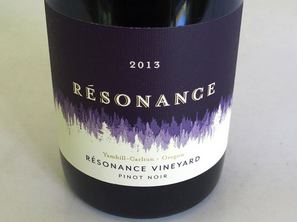
Domaine Nicolas-Jay, DundeeIn 2012 Jean-Nicolas Méo partnered with his friend of three decades, visionary music entrepreneur Jay Boberg, to found Domaine Nicolas-Jay (Nicolas left, Jay right in photo below). Jean-Nicolas has worked with legendary sites such as Richebourg, Clos de Vougeot, Corton Clos Rognet and Échezeaux at his winery in Burgundy, Méo-Camuzet. Given their shared love of Pinot Noir and their common goal to build something lasting, in 2012 Jay and Jean-Nicolas bought the organically-farmed, 13.5-acre Bishop Creek Vineyard located in the Yamhill-Carlton AVA. This site has a diversity of soils, clones and elevations.
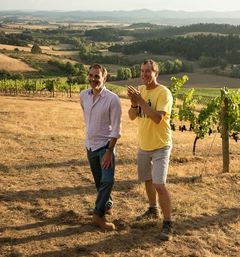 To complement the exceptional estate fruit, Jay, Jean-Nicolas, and associate winemaker Tracy Kendall (formerly of Adelsheim) have established relationships with famed vineyards through the Willamette Valley, including Nysa, Momtazi, Zenith and Knight’s Gambit. Jean-Nicolas now spends nearly two months in Oregon each season traveling throughout the spring, summer and harvest to oversee viticulture and winemaking. Jay spends up to 6 months each year in Oregon working in the vineyard and winery alongside the winemakers. The 2014 Willamette Valley Pinot Noir was their debut wine, followed by two limited single-vineyard designates. For more information, visit www.nicolas-jay.com. Wine presented at the Grand Seminar: 2015 Nicolas-Jay Willamette Valley Pinot Noir $65. Reviewed 6/25/17 in PinotFile - score 94.
Other Oregon wineries with a French connection: Beaux Fréres Maisons & Domaines Henriot, owner of Henriot Champagne, has bought a majority stake in this winery. Chapter 24 Mark Tarlov left Evening Land and started his second winery, Chapter 24. He joined with Viscount Louis-Michel Ligier-Belair in Vosne-Romanée. Three cuvées are offered: The Fire, The Flood and The Last Chapter. Cooper Mountain Vineyards Gilles de Domingo is a French-born winemaker, trained in Bordeaux, France, who made wine throughout the world before settling in the Willamette Valley. DePonte Cellars and 1789 Wines Isabelle Dutartre worked with Véronique Drouhin-Boss in Burgundy, followed her to Oregon in 1989, worked with her in Oregon and Beaune for many years, and became head winemaker at DePonte Cellars in 2001. Elton Winery, Lavinea Winery Isabelle Meunier initially came to Oregon in 2007 to oversee Evening Land Vineyards winemaking for Dominique Lafon, leaving that winery in 2014. She is now the consulting winemaker for Willamette Valley Vineyards new Elton Winery. Her own label, Lavinea Winery, features single vineyard wines. Hyland Estates, Soléna Estate and NW Wine Company. Laurent Montalieu is a Bordeaux native who has been making wine in Oregon for over 28 years. Double Zero Winery Lea Lafon, the daughter of noted vigneron Dominque Lafon, is the winemaker. Torii Mor Winery Jacques Tardy represents the eight generation of a Burgundian winemaking family from Nuits-Saint-Georges. He moved to California in 1982 and made his way to Oregon by 1990, joining Torii Mor as head winemaker in 2004. Van Duzer Vineyards. Florent-Pierre Merlier is a native of Burgundy who found romance with Krista, an Oregonian, while the two were interning at the same winery in Burgundy. Florent obtained his Diploma of Viticulture from the University of Dijon before relocating to Oregon in 2009, becoming the winemaker at Van Duzer Vineyards in 2004. Winter’s Hill Vineyards Delphine Gladhart is a French born winemaker was working at Lemelson Winery in 2001 when she met future spouse Russell Gladhart whose family owned Winter’s Hill Vineyards in the Dundee Hills, and she became the winemaker there.
The dates for next year’s 32nd Annual IPNC are July 27-29, 2018. If you want to join the IPNC mailing list and receive the e-newsletter, the IPNC Seasonal Post, contact IPNC at info@ipnc.org, or 503-472-8964, or IPNC PO Box 1310, McMinnville, OR 97128. For further information about IPNC or to buy tickets for next year’s event, visit www.ipnc.org. Join the over 16,380 Pinot Noir lovers from around the world that have travelled to McMinnville for a weekend of drinking Pinot, eating, learning, and celebrating together in honor of Pinot Noir.
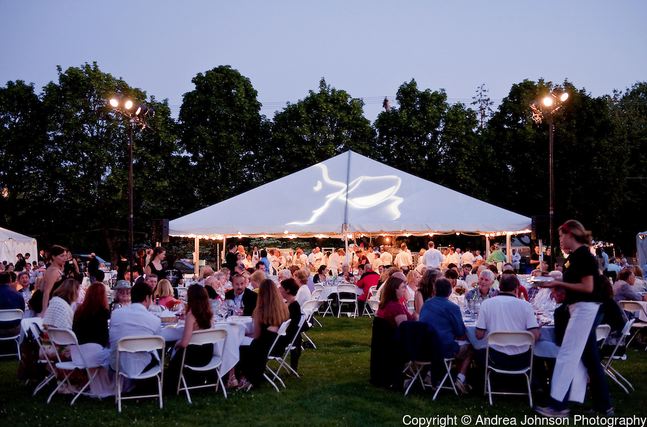
IPNC: The FoodOf course, everyone goes to IPNC for the Pinot Noir, but they come away talking about the food. The weekend ticket includes a luxurious buffet Breakfast on the Patio Friday and Saturday, a Winery Lunch one day and an alfresco Lunch on the Lawn in the oak grove on campus another day, The Grand Dinner Friday night, the Salmon Bake Saturday night, and the Sparkling Brunch Finale Sunday morning. More than 60 guest chefs team with Northwest farmers to utilize locally sourced sustainable ingredients to create the meals served throughout the weekend. They are assisted by staff from their restaurants, along with 50 other professional and amateur chefs who volunteer their time for IPNC. The chefs mostly hail from the Northwest, but over the years, chefs have traveled from all over the United States and parts of the world to cook for IPNC participants. I have included three menus here to give you an idea of what to expect if you attend the IPNC.
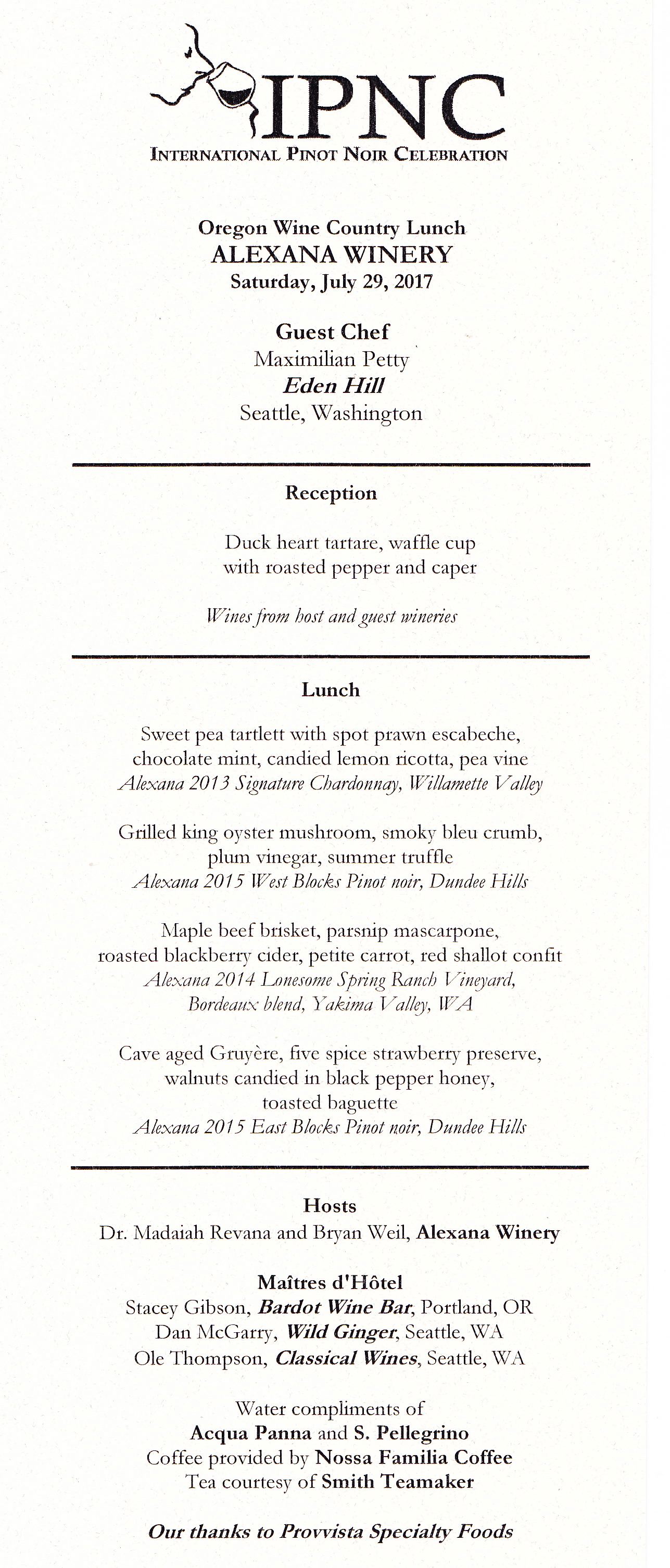
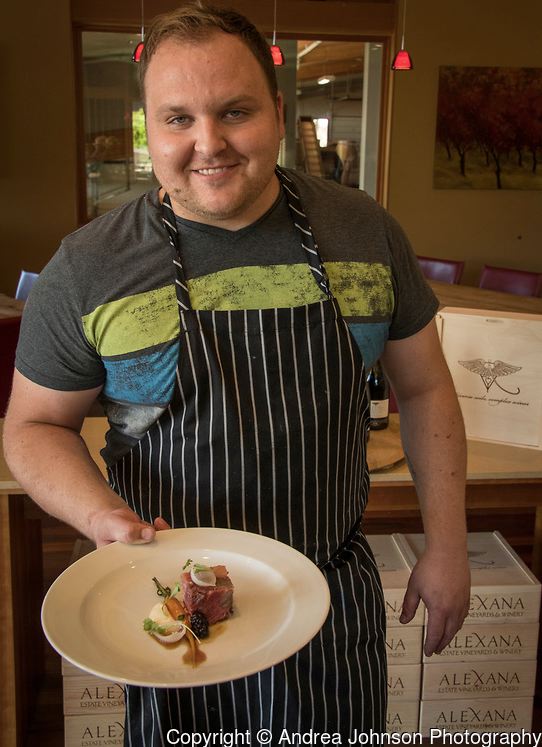
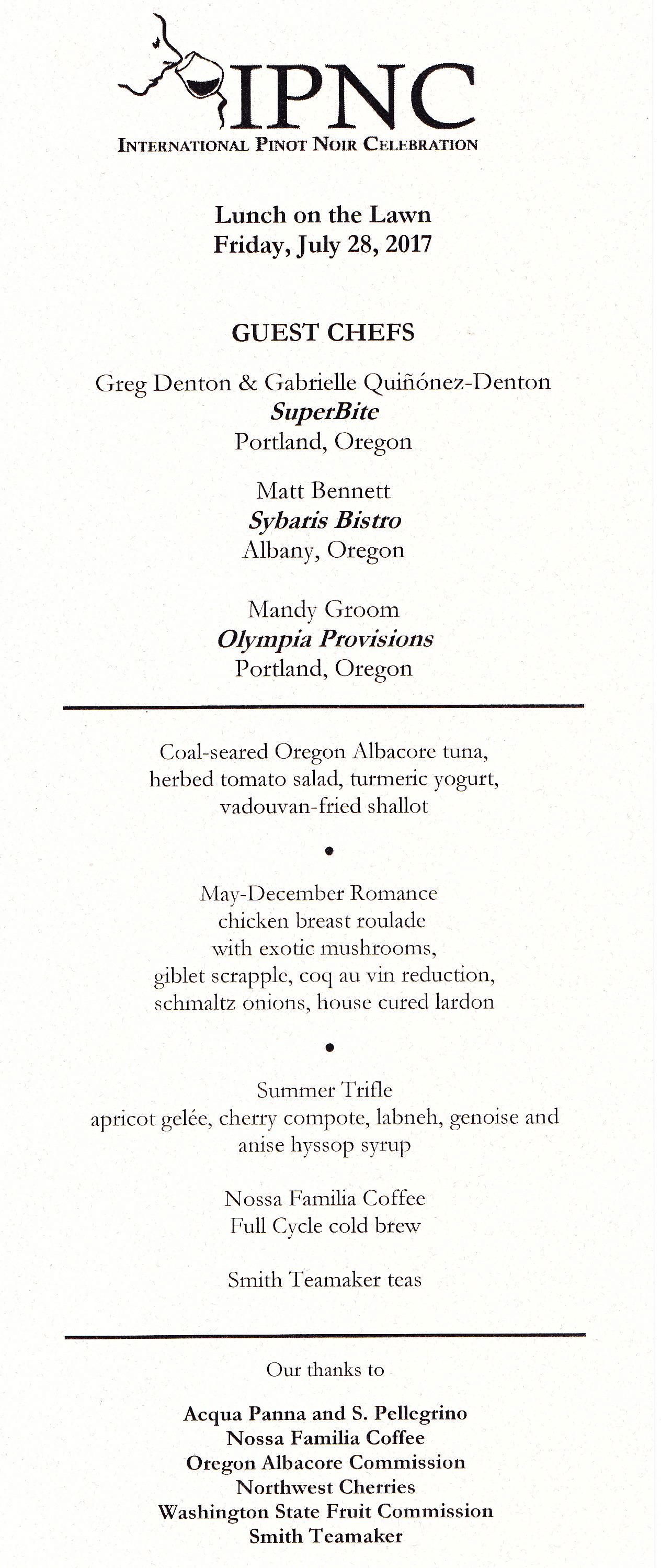
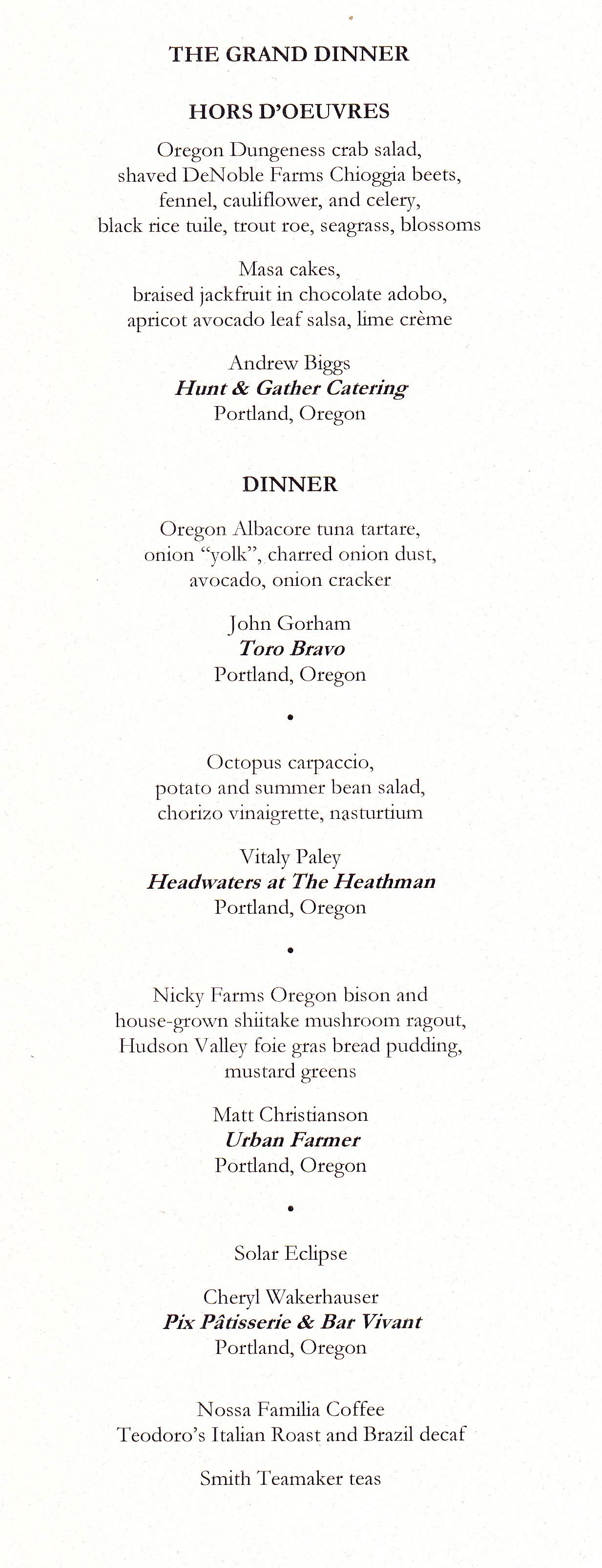
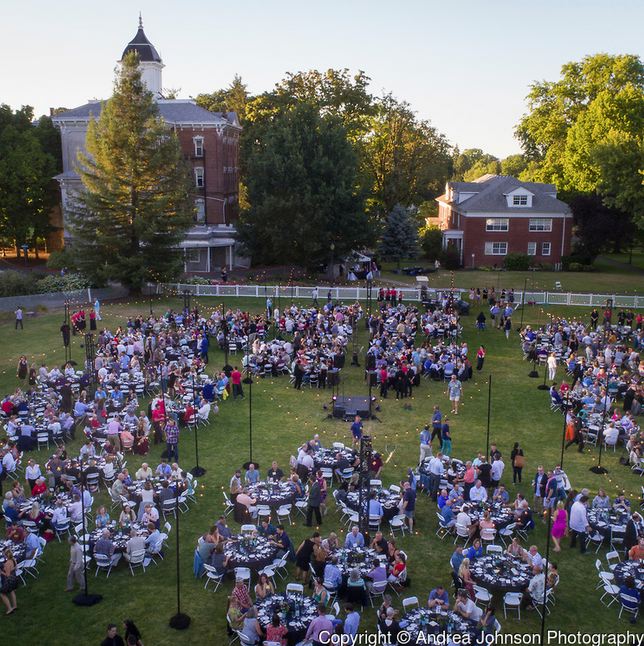
Sips of Recently Tasted Oregon Wines
Brittan Vineyards, McMinnvilleVeteran winemaker Robert Brittan is among several California winemakers who have moved to Oregon to craft Pinot Noir. Robert spent 16 years at Stags’ Leap Winery in Napa where he was the winemaker and estate manager. Along with spouse, Ellen, who will be President of IPNC for the 2018 IPNC event, the pair purchased a 128-acre hillside outside of the town of McMinnville tucked into the foothills of the Coastal Range. The original 18 acres were planted in 2001, but due to the challenging nature of the site and limited topsoil, only 8 acres survived. Since 2004, the vineyard has been a rehabilitation project with continued replanting. The winery’s first commercial release in Oregon was 2009. Robert produces block-specific Pinot Noirs from his estate vineyard in McMinnville. The Basalt Block has volcanic soils that lead to low yields and concentrated fruit flavors. The Gestalt Block is exposed to more wind, and is planted atop younger, more compact intrusion basalts. The 3-acre Cygnus Block was planted in 2008 to Swan selection.
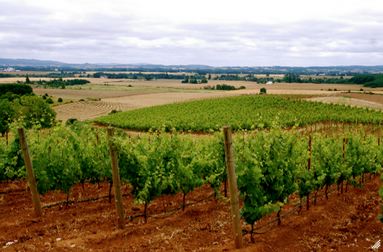 The winery’s tasting room is located in McMinnville and is open Thursday through Monday (check website for hours). To purchase wine, visit www.brittanvineyards.com. A Chardonnay and Rosé of Pinot Noir from sourced fruit are also offered.
2014 Brittan Vineyards Basalt Block McMinnville Oregon Pinot Noir 14.5% alc., 1,415 cases, $48. Pommard, 667, 777, 115 and Swan selection. Aged 12 months in French oak barrels, 25% new. · Dark garnet color in the glass. A very ripe fruited wine, with aromas of black fruits, prune, dark chocolate, vanilla, nutty oak, exotic spices and muddy earth. Impressive sap on entry in a mid weight plus style, underlain with a noticeable snap of acidity. Firm fruit tannins and a roasted tone to the fruit, with the slightest hint of alcoholic warmth on the finish. Score: 90
2014 Brittan Vineyards Gestalt Block McMinnville Oregon Pinot Noir 14.3% alc., 370 cases, $60. Clones 777, 667 and 115. Aged 12 months in French oak barrels, 35% new. · Dark garnet color in the glass. Aromas of beef, underbrush, and fresh Marionberry jam. A mid weight plus style, with an array of purple and black fruit flavors, supported by prominent fine-grain tannins and a welcome lift of acidity. The oak is well integrated, the texture is velvety, and the finish is remarkable for its persistence. Score: 92
2014 Brittan Vineyards Cygnos Block McMinnville Oregon Pinot Noir 13.5% alc., 150 cases, $65. Swan selection. Aged 12 months in French oak barrels, 35% new. · Moderately dark garnet color in the glass. A complex nose leads with aromas of blackberry, black cherry, undergrowth, fertile earth and nutty oak. The most elegant of the three 2014 Pinot Noirs, shot through with bright acidity, in a mid weight style featuring flavors of purple grape, anise, boysenberry and blackberry. Silky in the mouth, with a generous attack, integrated tannins, and a lengthy, deep purple fruited finish. Score: 93
Brooks Winery, AmityManaging Director Janie Brooks Heuck says, “Some people think we’re crazy to make 20 Rieslings and 16 Pinot Noirs from 30 vineyards every year, and they might be right.” But the winery’s founder, Oregon native, and Janie’s brother, Jimi Brooks, set out on a mission when he started Brooks Wines in 1998 to make expressive Willamette Valley Pinot Noir and Riesling. Jimi suffered a heart aneurism and passed away suddenly at 38-years-old, His son, Pascal Brooks, who was 8-years-old at the time, became the youngest winery owner in the world. He remains the sole owner of the winery. Brooks is now the living legacy of Jimi Brooks. Janie Brooks Heuck, Jimi’s only sibling, volunteers her time to lead Brooks and in 2008 purchased the 25 acres where the Brooks Estate Vineyard, winery and tasting room are located today. The winery has grown in production from 2,500 cases in 2004 to 19,000 cases today. Jimi’s longtime friend and winemaking accomplice, Chris Williams, has been the full-time winemaker at Brooks since 2005. Chris worked alongside Jimi at WillaKenzie Estate and Maysara Winery, and jumped in to help Brooks make wine when Jimi passed away on the eve of the 2004 harvest. I don’t claim to know a lot about Riesling and do not review Riesling in the PinotFile. That said, I have tasted multiple Brooks Rieslings on a few occasions, and can heartily recommend them. The 2015 Brooks Estate Riesling is made from some of the oldest Riesling vines in the Willamette Valley. Fermented naturally in stainless steel and aged another seven months, it is a special wine with 12.5% alc., pH 3.04, and RS 9 g/L ($24). The 2015 Yamhill Vineyard Riesling is made from vines planted in the Yamhill-Carlton AVA in 1987 on unique Willakenzie marine sedimentary soils. 85 cases are produced with 13.4% alc., pH 2.92, and RS 13.4 g/ L ($24). The 2015 Orchards Fold Riesling is sourced from a vineyard only a mile from Brooks and has been farmed by the Howard family since 1978. The vines are planted in volcanic basalt (Nekia, Jory) and farmed holistically with young sheep grazing between the vine rows and Muscovy ducks roam the vineyard. 100 cases produced with 11.5% alc., pH 2.94, and RS 13.6 g/L ($24). The oldest vines at Brooks 20-acre estate vineyard are 43 years old and the young vines are a little more than 15 years old. 11 acres of original plantings include Pommard, Riesling and Pinot Gris all on their own rootstock. The remaining acreage was grafted to Pinot Noir clones 777 and 115 in the late 1990s. The estate vineyard is Demeter Certified Biodynamic. Brooks Pinot Noirs all undergo gentle de-stemming followed by a 7 to 10-day cold soak. Lots are fermented in 2.5-ton stainless steel tanks. Fermentations are natural in tank and barrel. Aging is carried out in French oak barrels, usually for 18 months or longer and the wines are typically aged an additional 6 months after bottling. Interestingly, Brooks has consciously kept their wine prices the same since 2004. Jimi set out to make wines that locals could afford to drink, and Brooks has maintained that ethos with distribution across the country and at home in the tasting room. For more information, visit www.brookswine.com. The winery’s expansive tasting room in Amity is open daily (see location below). If you go, look for local vineyard owners who are likely to be in the tasting room.
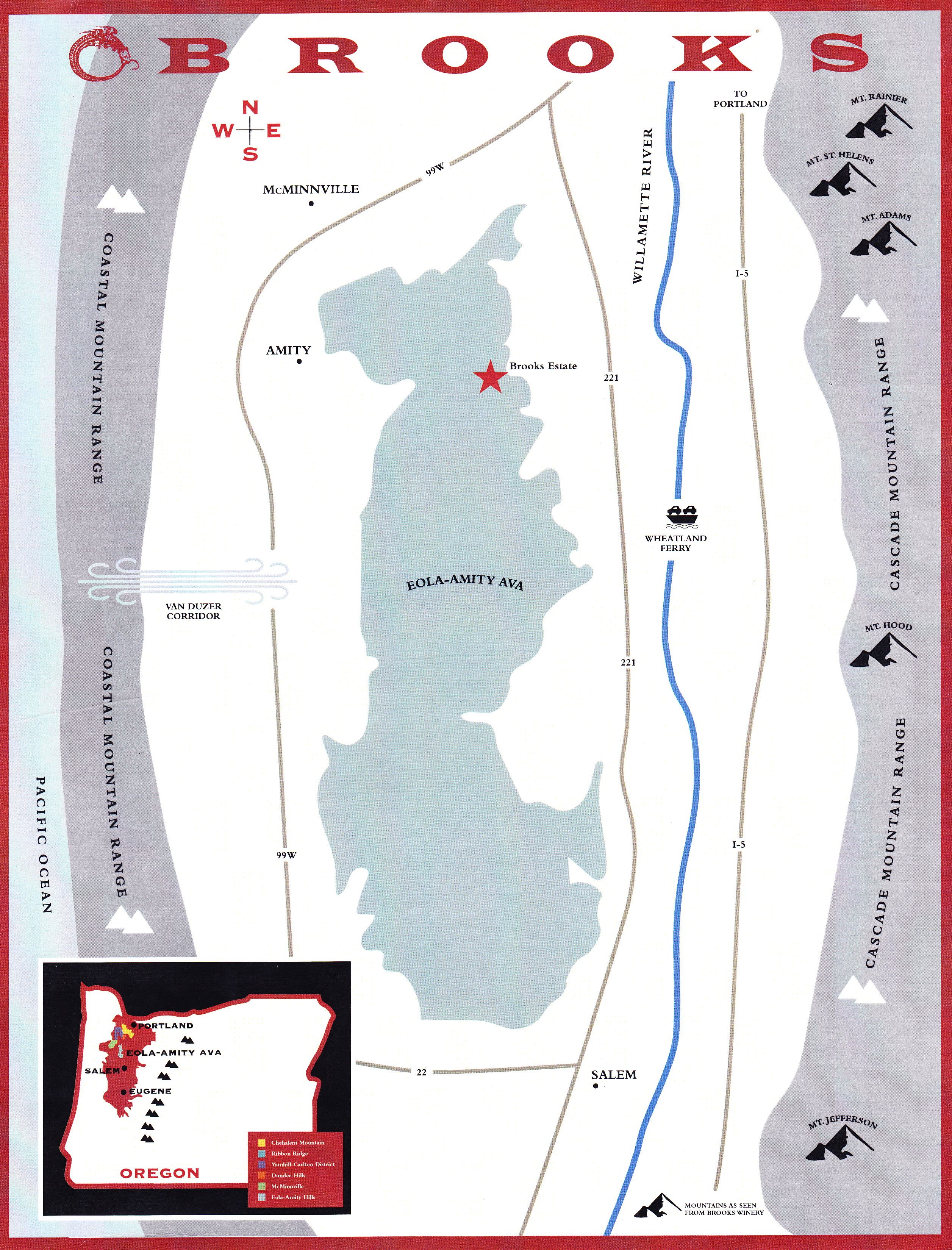
2014 Brooks Temperance Hill Vineyard Eola-Amity Hills Oregon Pinot Noir 13.3% alc., pH 3.69, TA 0.51, 250 cases, $48. 100% de-stemmed. 40% 777, 31% Pommard, 29% Wädenswil. Vineyard farmed by Dai Crisp. Nekia soil - well-drained, volcanic basalt from ancient lava flows. Dry farmed, certified organic vineyard planted in 1981 at 675 feet elevation. Native yeast fermentation, aged 18 months in French oak barrels. · Moderate garnet color in the glass. A rather fruity nose featuring dusty cherry aroma flanked by ground savory spice. Both earthy and fruity, featuring mid weight flavors of black cherry and blackberry supported by integrated oak and well-honed fruit tannins. There is a noticeable charge of fruit on entry with a pleasing finish (but not quite up to the Crannell Vineyard bottling). Score: 93
2014 Brooks Crannell Vineyard Eola-Amity Hills Oregon Pinot Noir 13.5% alc., pH 3.45, TA 0.60, 300 cases, $48. Vineyard farmed by Richard Crannell. Jory and Nekia soils - well-drained, volcanic basalt from ancient lava flows. Vineyard planted in 1984 at 550 feet elevation. Native yeast fermentation, aged 18 months in French oak barrels. · Moderately light garnet color in the glass. Engaging aromas of cherry, dusty earth, ground savory and white pepper. Delicious pie cherry core wrapped around suave tannins and accented with a kiss of oak. The flavor of this wine really hits home and the glorious cherry-driven finish seems to last a minute. Score: 94
 2014 Brooks Rastaban Eola-Amity Hills Willamette Valley Pinot Noir 13.8% alc., pH 3.70, TA 0.51, 500 cases, $55. Pommard, 115 and 777. Native yeast fermentation, aged 18 months in French oak barrels. The most intense and complex barrels in the cellar. The best effort for the vintage. · Moderately light garnet color in the glass. The intoxicating nose offers aromas of black cherry, cigar box and exotic spices. Very classy and impeccably balanced, with mid weight flavors of black cherry and ripe strawberry underlain with a pleasing earthiness. Impressive polish and verve, with enough structure for aging, although it is hard to keep your hands off it now. Score: 95
DANCIN Vineyards, Medford
DANCIN Vineyards is the sincere passion of Dan and Cindy Marca. The name, DANCIN, reflects the annual
dance in harmony with nature and humanity, with vines and wines. The wines are named primarily after
movements within ballet, a form of dance where dedication, discipline and balance lead to the grace and
beauty of the final performance. The name, DANCIN, also is formed from the first three letters of the Marca’s
names.
 The estate property is located in the Rogue Valley of Southern Oregon. The site is uniquely positioned for Pinot Noir. It is shaded for up to two hours a day at the hottest time of the day, and is situated at elevations of between 1,700 and nearly 2,000 feet. There are over 19 acres planted to Pinot Noir (two-thirds) and Chardonnay (one-third), and an adjacent Tuscan-styled tasting room, wine cave and winery. The winemaker since 2010 has been Brian Denner, a veteran who has worked at Williams Selyem in Healdsburg, Denner Vineyards in Paso Robles, and Kingston Family Vineyards in Chile. Visit the website at www.dancinvineyards.com.
2015 DANCIN Pas de Trois Oregon Pinot Noir 13.3% alc., 162 cases, $37. Sourced from DANCIN estate vineyard in Southern Oregon, and Hyland Vineyard and Aegrina Vineyard, both in the McMinnville AVA. Clone 777. After de-stemming, the grapes underwent a cold soak of up to 7 days. Native yeast fermentation, and aged 11 months on the lees in French oak barrels, 37.25% new. · Moderately light garnet color in the glass. Seductive aromas of fresh cherry, blueberry and toast. Light to mid weight flavors of red cherry and warm spices with a hint of oak and savory herbs. Smoothly textured, with gentle tannins, and a modest but pleasing finish. Score: 90
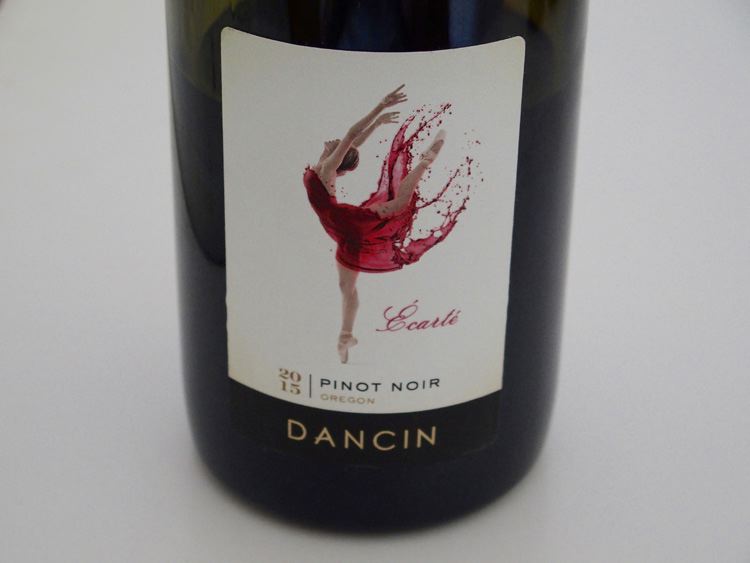 2015 DANCIN Écarté Oregon Pinot Noir 14.6% alc., 132 cases, $37. Sourced from Aegrina Vineyard in the McMinnville AVA. Average harvest Brix 24.1º Pommard clone. After destemming, the grapes underwent a cold soak for up to 7 days. Native yeast fermentation, aged 11 months in French oak barrels, 12.86% new. · Moderately light garnet color in the glass. Plenty to like in this middleweight wine with aromas of blackberry jam, spice box, beef jerky and warm brioche leading to flavors of sappy black cherry, dark chocolate and black tea. Impressive mouth presence and finish, with complimentary tannins and tucked in alcohol. Score: 93
2015 DANCIN Septette Southern Oregon Pinot Noir 13.5% alc., 94 cases, $37. Sourced from the seven original blocks and seven originally planted clones: 114, 115, 667, 777, “828,” Pommard and Wädenswil 2A. After de-stemming the grapes were cold soaked for up to 7 days. Native yeast fermentation, aged on lees for 11 months in French oak barrels, 38.61% new. · Moderately light garnet color in the glass. The nose offers a pleasant combination of fruit (dark red cherry) and savory (herbs, underbrush) aromas. This wine has a prominent savory edge along with a mid weight core of vivid black cherry fruit. Noticeable tannins ply the background and show up modestly on the finish. Score: 91
2015 DANCIN Plié Southern Oregon Pinot Noir 13.7% alc., 138 cases, $37. Sourced from three of the seven original estate blocks. Clones 115 (7% whole cluster) and Pommard. After destemming, the fruit underwent a 7-day cold soak. Native yeast fermentation. Aged 11 months on lees in French oak barrels, 39.17% new. · Light ruby red color in the glass. Shy, but comfortable aromas of red cherry and red berry. Lighter styled and primarily red-fruited. Easygoing and rather simple with a silky mouthfeel. The tannins stick out a bit on the bright finish. The wine does perform better over time in the glass. Score: 89
2016 DANCIN Capriccio Southern Oregon Chardonnay 14.0% alc., 90 cases, $32. Robert Young 17, Dijon 76 and Wente 72 clones. Average harvest Brix 23.5º. Whole cluster pressed into French oak, native yeast fermentation. No malolactic fermentation. Aged in French oak barrels on lees with weekly stirring, 20% new, 80% neutral. Gently filtered and bottled after 6 months. · Moderately light golden yellow color in the glass. Aromas of lemon creme, yeast, chalk and oak cask lead off. Modest richness of citrus-driven flavor, slightly creamy in texture, finishing with good brightness, but with a hint of alcoholic warmth. Score: 89
2016 DANCIN Mélange Southern Oregon Chardonnay 13.5% alc., 135 cases, $32. Robert Young 17, Dijon 76, 15 and 809. Average harvest Brix 23.7º. Whole cluster pressed into French oak and stainless steel. Native yeast fermentation. No malolactic fermentation. Aged on lees with weekly stirring in 30% French oak barrels (17% new and 13% neutral) and 70% stainless steel for 6 months before gentle filtering and bottling. · Moderate golden yellow color in the glass. The nose leads with scents of lemon curd, white peach and straw. Vibrant, with richly flavored notes of grilled lemon, pear and white peach. Nicely balanced and easy to cozy up to. Score: 90
de Lancellotti Family Vineyards, McMinnvillePaul de Lancellotti told me his family was not a winemaking family, but “mornings turned into evening and days out in the vineyards season through season,” led them to become one. The family built from the ground up. First with the planting of Paul’s father-in-law’s vineyard in 1998, then the creation of Bergström Wines in 1999, and next, the planting of their own vineyard. The experience gained in the early years led them to create their own brand, de Lancellotti Family Vineyards in 2005. The beginning years opened their eyes to biodynamic farming. Paul explains, “Biodynamic farming is a holistic practice that is largely misunderstood until you have spent a lifetime in vineyards. Attention to detail starts in a farm.” Today, de Lancellotti wines are a result of fruit sourced from some of the finest vineyards in Oregon including the winery’s home vineyard. The wines are produced in a shared winemaking facility in McMinnville, under the guidance of winemaking consultant Robert Brittan.
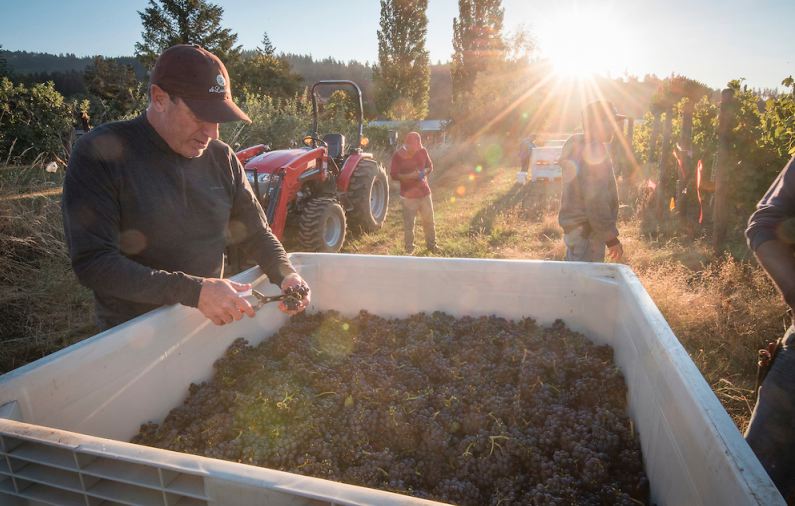 Paul says, “Simply put, farming great vineyards and sourcing the finest Pinot Noir and Chardonnay is our passion.” Tasting is by appointment in Newberg - refer to the website at www.delancellottifamilyvineyards.com.
2015 de Lancellotti La Sorella Willamette Valley Oregon Pinot Noir 14.5% alc., pH 3.50, 400 cases, $25. A three vineyard blend from biodynamically farmed vineyards. Native yeast fermentation, aged 10 months in French oak barrels, 20% new. · Moderately light garnet color in the glass. Reserved aromas of muddled black cherry, wine cave and underbrush. Noticeably riper fruited, with a core of black cherry and purple berry fruits accented by warm spices and a noticeable overlay of oak. Firm, but integrated tannins, juicy acidity, and a welcome finish. Score: 89
2015 de Lancellotti Famiglia Willamette Valley Oregon Pinot Noir 14.1% alc., pH 3.40, 200 cases, $40. sourced from the home estate vineyard in the Chehalem Mountains AVA. 15% whole cluster. Native yeast fermentation, aged 11 months in French oak barrels, 25% new. · Light ruby red color in the glass. Aromas of cherry and sawdust arrive over time in the glass. Bright and sleek on the palate, with light to mid weight flavors of red cherry and red berry, nicely spiced. Forward drinking, with a fortuitous cherry-driven finish. Still excellent when tasted the following day from a previously opened and re-corked bottle. Score: 92
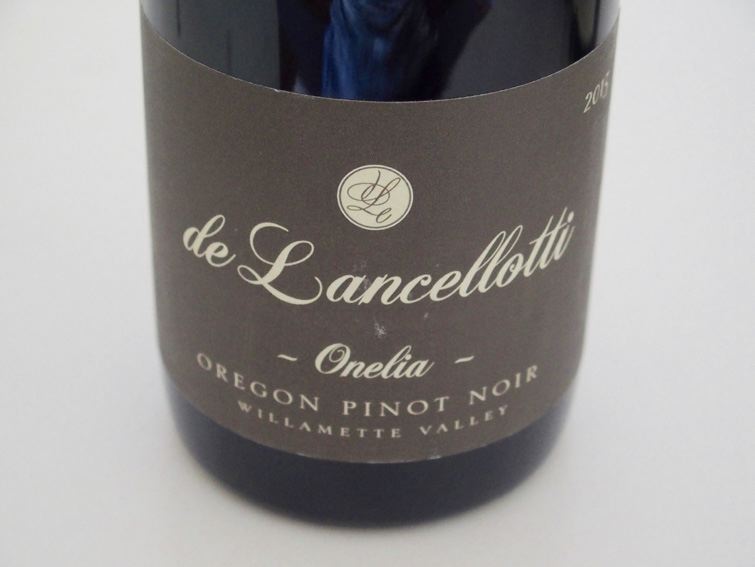 2015 de Lancellotti Onelia Willamette Valley Oregon Pinot Noir 14.4% alc., pH 3.40, 60 cases, $75. Sourced from Formaglini Vineyard. Clone 777. 30% whole cluster. Native fermentation, aged 11 months in French oak barrels, 30% new. · Moderately light garnet color in the glass. An array of aromas arrive over time in the glass including black cherry, ripe strawberry, spice and pipe smoke. Remarkable attack of mid weighted cherry, raspberry and strawberry fruits underlain with baking spices. Seamless, silky and sexy, finishing with charitable red fruited goodness. Score: 94
2015 de Lancellotti Lachini Vineyard Chehalem Mountains Oregon Pinot Noir 14.5% alc., pH 3.50, 220 cases, $60. Sourced from Lachini Vineyard located in the Chehalem Mountains AVA. 60% Pommard and 40% 115. 15% whole cluster. Native yeast fermentation, aged 11 months in French oak barrels, 25% new. · Moderately light garnet color in the glass. Aromas of wild strawberry and blueberry arrive with a bit of oak. A comforting wine with vivid flavors of black cherry and blueberry sporting impressive mid palate intensity. Satiny in texture, with the right touch of oak and a very generous finish. When tasted the following day from a previously opened and re-corked bottle, I was enthralled by the seductively smooth texture of this wine. Score: 94
2015 de Lancellotti Anderson Vineyard Dundee Hills Oregon Chardonnay 14.6% alc., pH 3.4, 150 cases, $50. Dijon 96, 26-year-old, own-rooted and organically farmed vines planted in Jory soils. Native yeast fermentation, aged 11 months in French oak barrels, 10% new. · Light golden yellow color in the glass. Intriguing aromas of chalky lemon, steel and minerality for want of a better word. Lovely, energetic and bright, with flavors of lemon and lychee without needless oak encumbrance. Very engaging and satisfying. Score: 93
Pinot BriefsWin a Chance to Hang in Wine Country with Jennifer Lawrence We know that Jennifer likes wine and it would great if she would promote my website. However, she is offering an opportunity to hang with her in wine country by donating to Represent.Us at www.omaze.com/experiences/jennifer-lawrence-winepicnic? ref=jen. Represent.Us is an organization working to bring everyone together to pass anti-corruption laws that stop political bribery, end secret money, and fix our broken elections. A promotional video of Jennifer playing “Movie Review or Wine Review” is hilarious: www.youtube.com/watch?v=tp-PWArtsvM. The more money you donate, the greater your chances to win. Winner will be flown to California and put up in a 4-star hotel, picnic among the vines, play lawn games at the vineyard, and go wine tasting with Jennifer.
 European Study Finds Wine Tastes Better If You Think Its Expensive A new study from Germany published in the journal Scientific Reports had a focus group of 30 people sample wine at various price points. The individuals lied down in an MRI scanner and were shown how much the wine cost and tried the wine through a tube in their mouths, then rated the wine. What the participants did not know was that they were tasting a series of identical wines with different supposed prices. The subjects reported that the wine with the higher price tasted better than an apparently cheaper one. The parts of the brain associated with decision making and reward processing were activated more with higher prices. Emeritus Vineyards Wins USA Today’s Best Winery Tour 2017 Emeritus Vineyards was voted #1 out of 20 nominees in the USA Today 10 Best Readers’ choice travel award contest for best U.S. winery tour. Nominees were chosen by a panel of wine experts, writers, journalists and sommeliers. Emeritus’s new tasting room opened in 2015 overlooking the famed Hallberg Ranch Estate Vineyard in the Russian River Valley. The winery’s Pinot Noir from that vineyard is the #2 most requested Pinot Noir in America’s Zagat rated restaurants. A tour at Emeritus goes from dirt to glass through the Hallberg Ranch Estate Vineyard and winery. Guests start with a closeup tour of the vineyard, then proceed into the winery where they experience the activity of the season. They then settle into the tasting room for a flight of estate grown and single vineyard Pinot Noirs. Hosts guide the tour and tasting to match guests’ experience levels. Tours are offered Thursday- Monday by appointment. The tours last about 90 minutes and cost $30 per person. Schedule an appointment at www.vinovisit.com/widget/search/?wineryID=3555. September is California Wine Month September marks the 13th annual California Wine Month. Visit www.discovercaliforniawines.com/californiawinemonth to view a list of events by date and get a copy of this year’s “2017 California Wine Month Facts at a Glance” poster (see below). A map of California wine regions and the 128 AVAs can be downloaded as well.
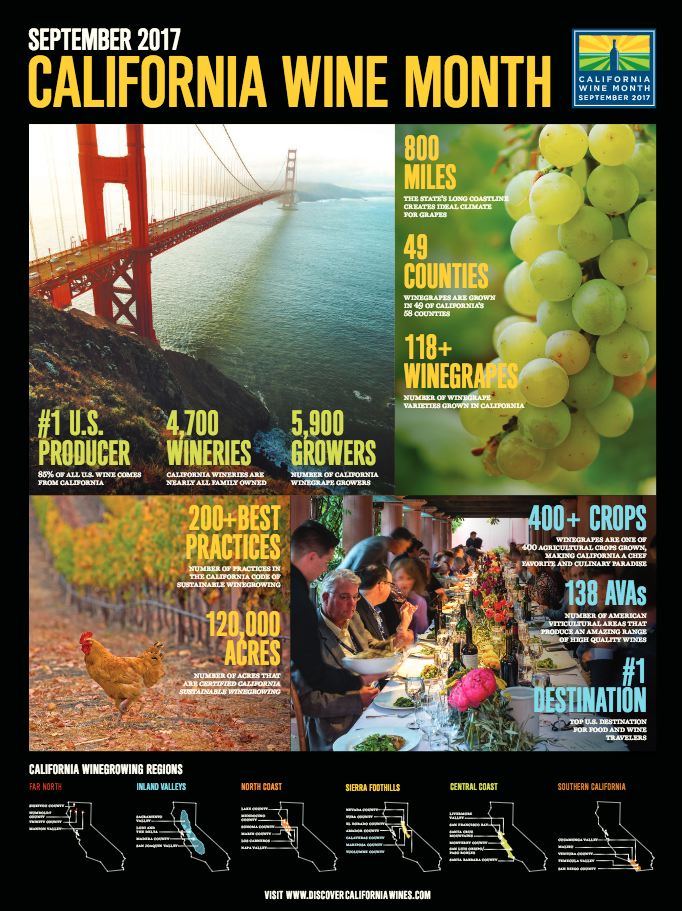 Cambria Winery Names Jill DelaRiva Russell Winemaker Denise Shurtleff, the veteran winemaker at Cambria, has been promoted to winery general manager, and Jill DelaRiva Russell will become the winemaker working alongside Shurtleff. Cambria Winery, located in the Santa Maria Valley, produces 100% estate grown and bottled Pinot Noir and Chardonnay from Katherine’s and Julia’s vineyards. Cambria was founded in 1986 by Jess Jackson and spouse Barbara Banke, and is celebrating its 31st anniversary this year. Russell (pictured below) developed her winemaking and regional expertise as assistant winemaker at Stephen Ross Wine Cellars in San Luis Obispo and as an assistant winemaker at Paul Lato Wines in Santa Maria. Cambria Winery has just launched their Estate Inspired Wine Series of Pinot Noir and Chardonnay focusing on different micro sites throughout Cambria’s estate vineyard in the Santa Maria Valley. Visit www.cambriawines.com.
 Duckhorn Wine Company Acquires Calera Wine Company Calera Wine Company, founded by Josh Jensen in 1975, played a pivotal role in establishing Pinot Noir as one of North America’s great varietal wines, and Calera became one of California’s most acclaimed Pinot Noir producers. The sale to Duckhorn Wine Company includes the Calera winery, the grand, the tasting room, the 85-acres of estate vineyards, and all inventory and assets. Calera will continue to produce its portfolio of wines at its gravity flow winery in Hollister, California. All key personnel, including winemaker Mike Waller, will remain with the winery. Jensen (pictured below), who is 73 years old, will continue to remain involved at Calera, and will join the Duckhorn Wine Company Board of Directors, where he will serve alongside his longtime peer, Dan Duckhorn.
 Monterey County Now California’s Biggest Pinot Noir Producer By Volume Wines & Vines reported in August 2017 that Monterey County now grows the most Pinot Noir in California and produces the second-largest amount of Chardonnay, according to the 2016 crop report. Monterey County now produces 58,419.9 tons or 23% of the Pinot Noir grapes crushed in California in 2016, 37% more than second place Sonoma County and Marin County. Monterey has many more vineyard acres than wineries. For example, Napa Valley and Monterey County AVAs each have about 45,000 acres of vineyards, but Napa Valley has 400 wineries compared to Monterey County’s 71. Most of the Monterey County Pinot Noir and Chardonnay comes from the northern part including the Santa Lucia Highlands, Arroyo Seco, Monterey and Chalone AVAs. Wine Studies at Linfield College Linfield College in McMinnville, Oregon, hosted the first International Pinot Noir Celebration 31 years ago and has been the festival’s home each year since. Linfield College’s Online and Continuing Education Department offers two wine-related certificates: Wine Management and Wine Marketing. In 2011, the school established the Oregon Wine History Archive that is committed to preserving and sharing the story of Oregon wine. Linfield College also offers a wine studies minor paired with a diverse selection of majors to prepare students for careers in the wine industry. To learn more about wine education at Linfield College, visit www.linfield.edu/wine or call 503-883-2766. Hidden Cellars Decades ago, Oregon’s pioneering wine families conducted sales from their fledging estates in a convivial atmosphere. Oregon became known for intimate tastings led by hands-on producers. Today, a small collective of top notch producers maintain the personal experiences of Oregon’s early wine days. They are members of Hidden Cellars. Hidden Cellars wineries only offer tastings by appointment in an uncrowded, unhurried environment, poured and narrated by the owners who are often the winemakers. Their wines are rarely found in retail stores since their production is limited and sold largely, if not exclusively, to individual wine connoisseurs. If you have a desire to acquire hard to find wines, you are invited to contact any of these wineries for an extraordinary experience in their private tasting rooms: Beckham Estate Vineyard (971-645-3466), Privé Vineyard (503-554-0464), Anderson Family Vineyard (503-554-5541), Native Flora (503-504-1990), Dukes Family Vineyards (503-835-0620) and Redman Vineyard & Winery (503-554-1290). Report from Oregon Pinot Camp Approximately 250 members of the wine trade from the U.S., along with a smaller international delegation, are invited to Oregon by the Pinot Camp (a group of some 50 leading Oregon wineries) to learn about the local viticulture, winemaking techniques, and, in particular, Pinot Noir. Doug Wregg published a good article on Oregon Pinot Noir and his impressions upon returning from Oregon Pinot Camp 2017: www.harpers.co.uk/news/fullstory.php/aid/22116/ Oregon__96_Pinot_Noir_and_Life_Beyond.html. Grape-Free Wine Developed Three biochemists and founders of Ava Winery in San Francisco have made a synthetic, grape-free Moscato d’Asti in their lab by cloning many chemical compounds found in wine. They are currently trying to produce a synthetic Pinot Noir with a combination of ethanol, water, sugar, amino acids and a number of chemical compounds that wine its aroma, flavor and body. The trio break down red and white wines into their components and then source the component molecules from those commercially available from the food industry. Ava Winery hopes to put wines in the marketplace in the U.S. by the end of 2017. Read the article: www.thedrinksbusiness.com/2017/08/grape-free-wine-developed-in-america/. Pinot Vs Pot I recently read an interesting article online about the battle between the Wagner family and their neighbors. The Wagner family own property in Yamhill County and want to grow cannabis. This has set off a confrontation with neighboring grape growers who fear spray drift and other unfavorable effects on their vines. Mahmood (Mo) Momtazi of Momtazi Vineyards in McMinnville, who has almost 600 acres of biodynamically farmed vineyards near the Wagner property, is in a legal battle with the Wagners. The exact effect of cannabis fields on adjacent vineyards is unknown at present. This is currently a heated topic in the Willamette Valley. The article can be read at www.buzzfeed.com.
In Vino Duplicitas
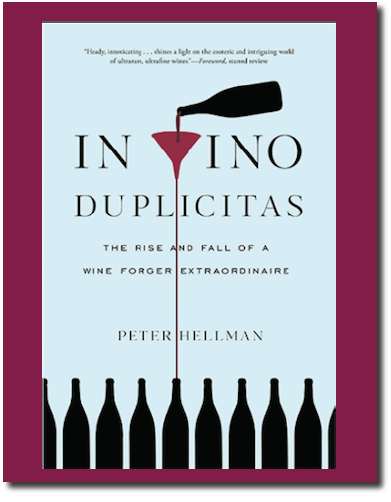 New-York-based journalist Peter Hellman unravels the astonishing story of Rudy Kurniawan, a charming young Indonesian (undocumented) immigrant, who seemed to come out of nowhere to gain entrance to the elite group of wealthy, U.S. wine collectors who gathered often in the early 2000s to drink ultra rare wines. With a seemingly unlimited budget, Kurniawan, who was nicknamed “Dr. Conti,” spent millions to acquire extremely coveted and scarce bottles of wine that were his ticket to the rare wine tasting fraternity. However, the reality was that there was a very limited supply of ultra rare wines, so he also created knock-off wines at his home that were clever fakes, sold them through auction or directly to collectors, shared them at dinners, and duped the supposed sophisticated palates of a number of prominent billionaire wine drinkers. Kurniawan eventually got caught when in 2008 his lots of Domaine Ponsot red burgundy offered in an auction were exposed as fakes by the winemaker, Laurent Ponsot. When this was revealed, Peter Hellman became enthralled with the story and this book offers Hellman’s exhaustive investigation of the Kurniawan con story including Kurniawan’s takedown by the FBI and the details of his eventual trial and conviction. Kurniawan’s victims and their losses included David Doyle ($13.1 million), Brian Devine ($5.3 million), Michael Fascitelli ($3.6 million), Andrew Hobson ($3.1 million) and Bill Koch ($2.1 million). Although Hellman is able to give many details of how Kurniawan made counterfeits of rare bottles of wine, there remain many questions yet to be answered. Where did his wealth come from? Did he work with one or more accomplices? Hellman was never able to get the full story from Kurniawan himself who has turned down all requests to visit him in prison, or from Kurniawan’s mother with whom Rudy Kurniawan lived. I enjoyed this almost stupefying story on the airplane to and from this year’s IPNC in Oregon. It brought back memories I had of reading reports of tastings by John Kapon of the New York wine auction house, Acker Merrall & Condit, in which ungodly numbers of ultra rare Burgundies were opened, fawned over, and consumed at one sitting. I thought at the time this was a stupid waste of great wine. It is now laughable, and I am sure embarrassing to those who attended these tastings because a number of these bottles were probably Kurniawan’s forgeries. |